1964: Act 2: Ben's pain (the civil rights era)

 15
16
17
18
19
20
21
22
23
24
15
16
17
18
19
20
21
22
23
24

Summary
In the first part
of act 2, Reed humiliated Ben and replaced him as the alpha male. This
can be seen as representing the rise of educated elites over blue collar
workers who once saw themselves as the "real"
Americans. But in the age of explosive economic and economic growth it
looked like the future belonged to scientists and the wealthy. This
conflict, between infinite possibilities and those who were kept down
(issues 15-19), led to civil unrest when the underclasses rise up
(issues 20-23: note the racial element in issue 24) and the warning that
somebody who seems weak may in fact hold the power to destroy
everything (issue 25).
15
Issue 15: Ben begins his act. (The decline of blue collar work and rise of computers.)
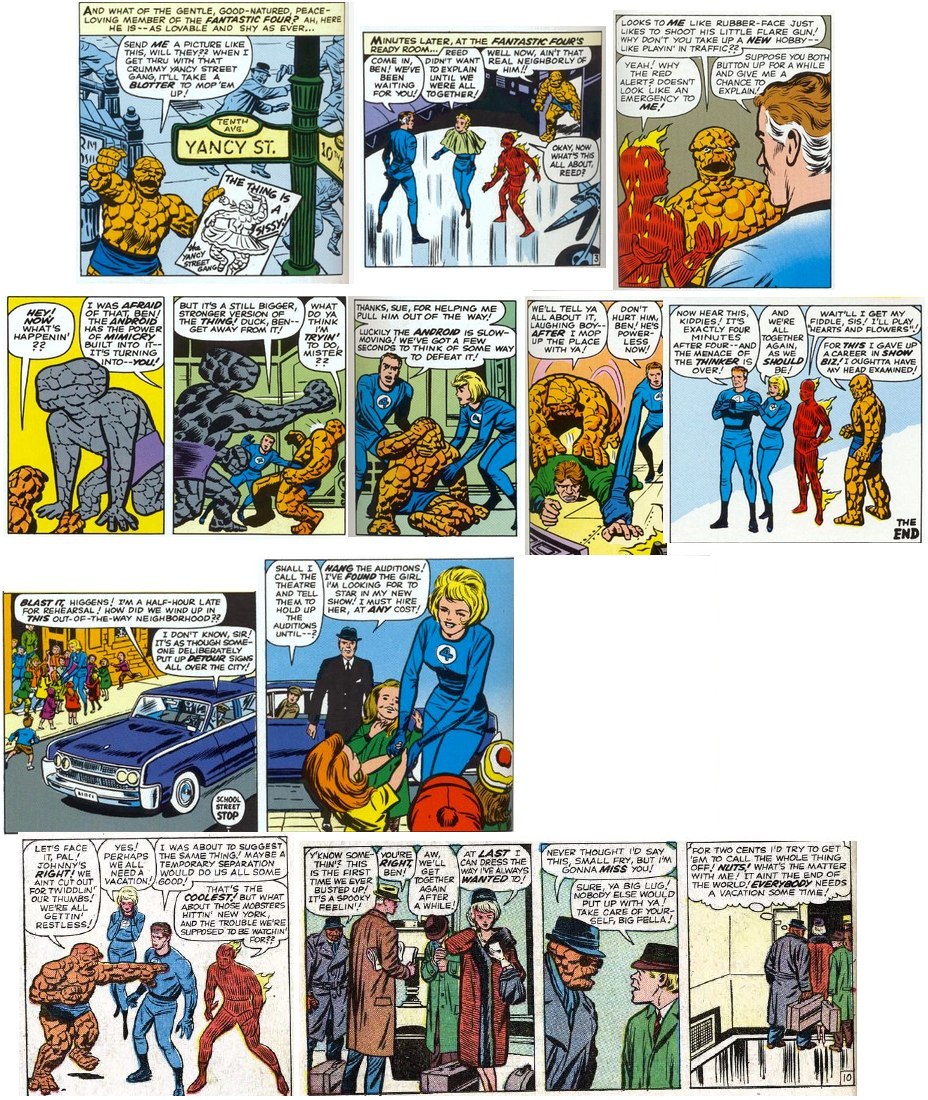
Ben starts to (wise) crack
After Reed's triumph, Ben accepts he is now subordinate. Ben, once a leader, a handsome fighter and test pilot, is now
like a child to a nerd. His old gang sees this and calls him a
sissy, and it hurts. Notice how Reed jokingly refers to the others
as "kiddies" and tells Ben he's too weak to fight the android (not true), and Ben believes him. At
this point Ben is finally dependent on the team: before this he
always welcomed the chance to get away. Ben begins to use humor to cover his frustration:
e.g. his reference to his "pantin' public." This is black humor.
he feels ugly and belittled, so jokes about his popularity. This
will be his defining personality for the rest of act 2 and
throughout act 3, until Reed's control finally breaks in act 4.
Reed and Sue
The separation in this issue foreshadows the same situation in issue
107: Reed's constant control is unhealthy and they need time apart.
The difference is that this time Sue is willing to give Reed's
micromanagement a chance. By 107 she has tried it Reed's way for six
years and it doesn't work. Sue's need for nice clothes will be
explained in issue 31: she never had a childhood, never had time for
herself. Notice also that she's a natural beauty, as Namor observed
in issue 4. Combine that with an understanding that often exceeds
Reed's, and Sue is the stand out character in the team, not Reed.
her beauty makes Ben feel his ugliness all the more.
The zeitgeist:
circuses and wrestling
From the FFPlaza review by Greg Allinson:
"Bones
n' Bailey's Circus" is obviously a play on Barnum and Bailey's
Circus, just as "General Electronics" is a play on General
Electric. Given the Midwestern setting, Ben's wrestling match
was likely held at the Kiel Auditorium in St. Louis and promoted
by the popular National Wrestling Alliance President Sam
Muchnick. The NWA was the most powerful governing body in
wrestling at the time, and Muchnick's St. Louis territory was
one of their strongholds. Ben was likely bought in as a one-shot
or short-term "special attraction," who would either lose to
Fatal Finnegan or wrestle him to a draw or disqualification,
thus increasing Finnegan's popularity and establishing him as
the equal or superior of the world-famous Thing. Muchnick
couldn't've been happy about Ben deviating from the match as
booked and not only defeating Fatal Finnegan, but destroying and
humiliating him in the process. Ben was probably blackballed
from the NWA and wrestling at large afterwards. In any event,
Ben didn't formally take up a wrestling career until The Thing#28 (1986), where he joined the
Unlimited Class Wrestling Federation. He remains a wrestling fan
to this day, as revealed in FF#489, where it's revealed that Ben
watches WWE (World Wrestling Entertainment) programming.
(Special thanks to The Wrestling
Observer Newsletter, Kayfabe Memories, and Wrestling Titles for background info on Sam Muchnick
and St. Louis wrestling in 1963)."
Realism: the Yancy Street Gang
By his stage, Jack Kirby is beginning to relate to Ben Grimm, not
Reed Richards:
- Jack Kirby's real name is Jacob Kurtzberg. his father was
Jacob Benjamin Kurtzberg. Ben's full name is Benjamin Jacob
Grimm.
- Both are Jewish (this was not made explicit until the
Franklinverse era, but there is a 1976 Jack Kirby sketch of Ben
Grimm as Jewish.
- Both grew up on the poor lower East Side of New York.
- Ben was bothered by the Yancy Street Gang, and was later
revealed to be an ex-member. Yancy Street is named after Delancy
Street, the main street in Kirby's neighborhood, and he was in
the street gang.
- The Thing's brother died when he was young (we learn in John
Byrne's The Thing title). Kirby's brother died when he was
young.
1963 and the rise of computers
The Mad Thinker is the villain who turns up most often in the 1960s.
Why? Because he represents the biggest change in America: the rise of
the computer and of robotics. FF 15 was published in 1963. This is the
year when the worlds first mini computer, the LINC, began to
circulate beyond the lab. It is also the year of the "Rancho arm",
arguably the first computer controlled limb. In the Fantastic Four this
becomes The Awesome Android, a faceless humanoid form able to duplicate
anything a human does. The Thinker himself is of course modeled after
Rodin's famous statue of the same name.
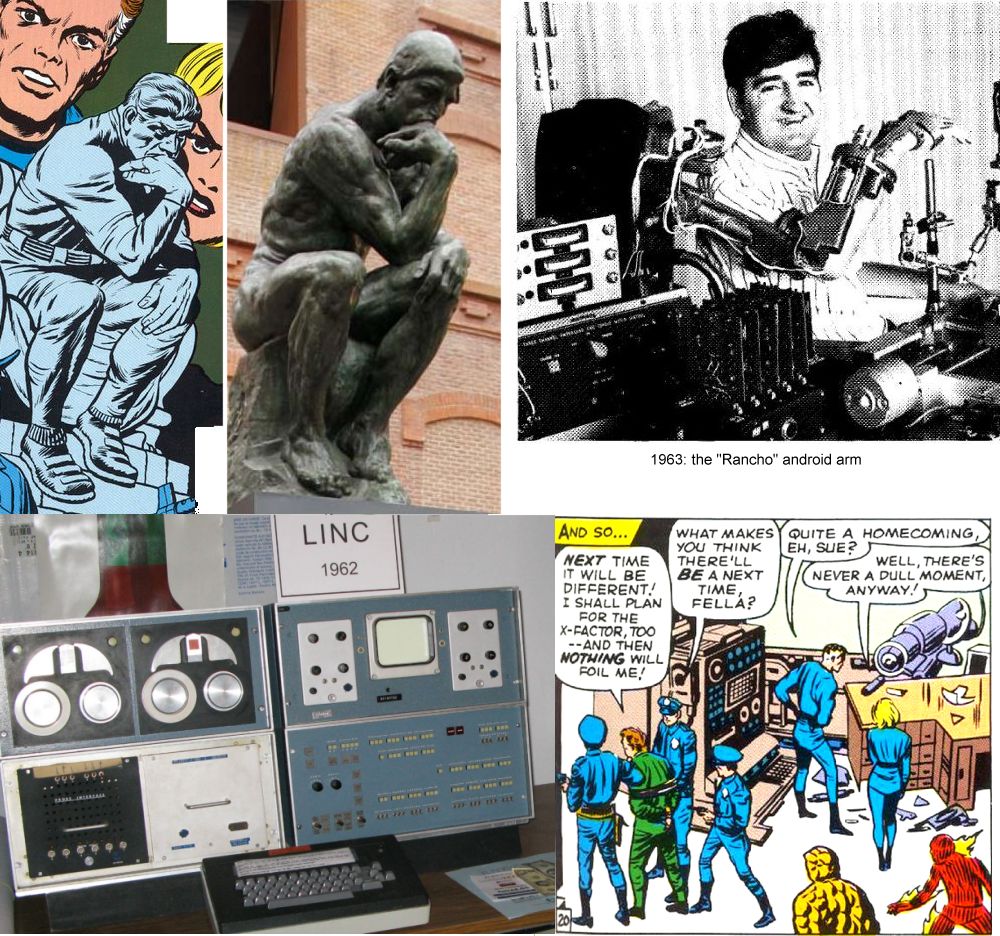
The next year (1964) would see "Eliza", the first program designed to
pretend it is human, and also the rise of the printed circuit, the next
revolution in computing. The Mad Thinker's plans usually fail,
reflecting the limitations of these early computers, but he always comes
back with a better design.
The class system and the height of Reed's arrogance
After the triumph of issue 14, this issue is about the rise of the
elites: the rise of computers and other technology. This
means blue collar workers are, for the first time in history, seeing
their role threatened. The story begins with Reed showing his absolute
dominance by making everybody else drop what is important to them, and
instead attend to Reed's whim. Note that the others gain pleasure from
social situations (Johnny dating, Sue being pampered in the salon, and
Ben play-fighting with old friends) whereas Reed is alone, trying to
create his own life forms to dominate.
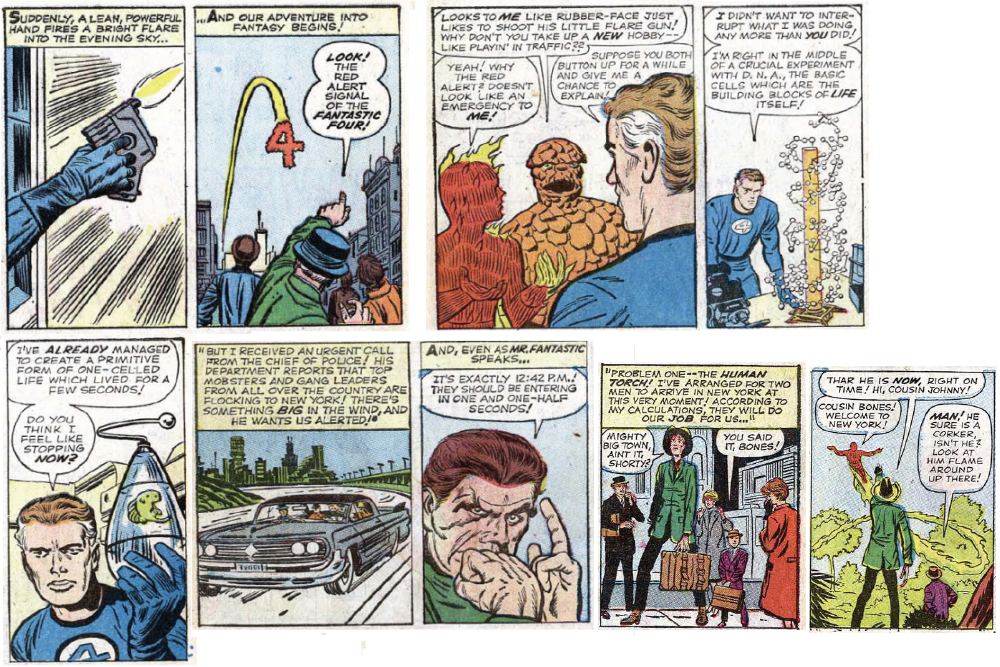
The times given in the story are often cited as a mistake: "evening" becomes
"12:42pm", and Johnny, shown at first listening to Reed, is now seeing his relatives while the Thinker is still talking.
But look closer. Look at the start, Reed's arrogance and how Ben and
Johnny react. See this in the context of the previous issue. The timing
speaks volumes. The story begins in the evening, when Reed calls the
team to a crisis that is not a crisis. In reality he is just annoyed
that his research was interrupted by the police request, a request he
has to answer, since he is now in good standing with the authorities,
and needed them to fund his rocket. So he takes out his frustration on
those beneath him. Reed lectures them with the situation as he sees it,
in great detail, and he is still talking the next day at 12:42 PM! But
by this time Johnny, who still has self confidence, has left to respond
to his telegram. With Johnny gone, Reed must decide his briefing has
gone on long enough, and as some time between 12:42 and 4pm the
remaining team members respond to their telegrams.
So rather than being a mistake the timing is a powerful statement of
Reed's arrogance at this point: his fatal weakness that will, in act 4,
lead to his decline, misery, and death.
Ben's misery
Blue collar workers are of course represented by Ben Grimm, the man from
the streets who made good. Yes, blue collar workers can have advanced
degrees as well, but they identify with the ordinary people. But Ben now
identifies with Reed, the elite who belittles him. So the his old
street gang consider him a "sissy". Ben is abused by his new
friends and abandoned by his old ones.This is the start of his long
period of depression.
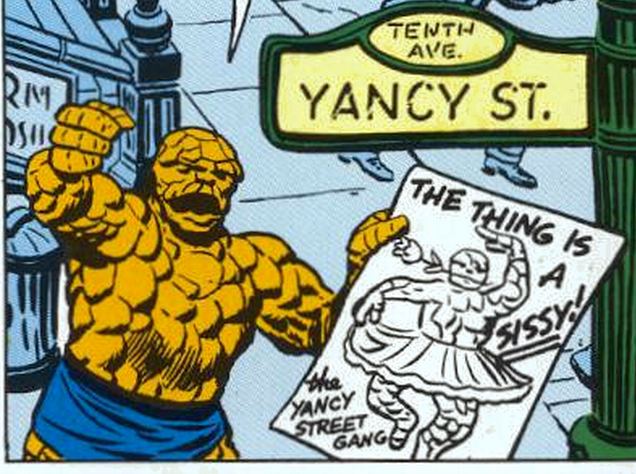
Note his comment as he leaves, "for two cents" he would cancel the
vacation. The team is the only family he has, and even the team are
splitting apart.
More character development
- The Thinker
The Thinker studies all available data, but Reed's reliance on
Willie Lumpkin surprised him. The Thinker did not expect this
because it goes against Reed's natural arrogance. The Thinker
could not know the most recent development, that in FF14 Reed
consciously accepted that nobody is master of his own fate. This
wisdom foreshadows the lesson that Reed must learn in act 5, but
he fails to see its implications until the end: Reed continues
to treat the others as inferior. - The Thinker as a mirror to Reed
Whereas Doom reflects Reed's
arrogance, the Thinker reflects Reed's belief in
micromanaging. The Thinker always misses some key point, just
as Reed fails to see the value in Sue's approach and prefers
to take a narrow view, often with disastrous results (as we
just saw in annual 1) - Reed's "first child"
The Android was a joint creation between reed and the Thinker: both are married to science, and this is his first "child." - Ben and Johnny
Pages 1-3 mimic the start of FF1, to highlight the two differences: the
Thing is now a sad clown, and Johnny is now feeling restricted by his
membership. That feeling of being trapped will dominate him now until
act 5.
- Work
the offers of work were similar to the offers made in the previous
issue, FF14. This time they accept. The offers are better: they help
others. E.g. they need johnny to save the circus. The Mad Thinker knew
this would make them agree. Johnny's one performance was enough to get
publicity for the other acts in the circus. - The Baxter building
This is the first time the FF battle their own building. This later becomes a trope.
Technology
-
The computers
Where did the Thinker get such
advanced computers?
Advanced technology generally comes from abandoned alien
craft. There is no need to assume more than one. A working
hypothesis is the Skrull space plane used by Doom in FF6. Doom
may have sold on the computing components on the black market,
because at that time his focus was on the occult. Doom did not
shift his emphasis to machines until he obtained the windfall of
Ovid technology in FF10. (Doom's early robots were likely
simple devices animated by a simple demonic spell.)
- Unstable molecules
The splash page declares the android to be "neither animal, vegetable
nor mineral", implying that it is not defined by its chemical structure,
but instead by its sub-atomic structure. See the page on super technology to
see how his unstable molecules can imitate any chemical structure they
need. The Thinker's android is the key to understanding the nature of
unstable molecules and their development over the years. - The Skrull uniforms
Elsewhere
I argue that the uniforms are derived from the Skrulls.uniforms. So
they only have two sets of reliable clothes: the original irradiated
costumes and the Skrull ones. Here we see the team's frustration in
having to wear them.
"Here’s a little side issue that
surprised me. Within this story, there are two complaints about their
uniforms! First, when they are all heading out to 'do their own thing,'
Sue
exclaims, 'At last I can dress the way I’ve always wanted to!' Is Sue
saying she wants to dress like a star? Or perhaps: 'Hallelujah! At last I
can get out of that dreaded blue uniform!' Then later, when they return
from their 'vacations,' Reed observes that
it feels wonderful to be back in the harness, and 'If you ever hear me
knock these uniforms again, just…' So this tells me Reed has 'knocked'
the uniforms before. I don’t recall that happening, do you? Maybe it
took place behind the scenes. But clearly, he is also not happy with the
uniforms." (-Crissy)
This helps to explain Reed's interest in
duplicating unstable molecules himself. If he can understand these
molecules then he can not only make better costumes but understand super-science itself.
- Turning off the android
How does Reed know how to turn off the android? How can an android even
be turned off? The android can change to any shape so is essentially the
same as the one Reed made. An unstable molecule based life form has
every sell the same, so needs some designated control point. Apparently
Reed chose the control point to be the base of the primary limb. That
makes a lot of sense, as every life form will need some kind of primary
part, for coordinating with other parts. In this case the android is
clearly right handed.
Art, lettering, etc.
- Kirby's original plan
The art (without the dialog) suggests that Kirby's original plot had
Reed create artificial life, and that is what interested the Thinker.
Then at the end the "X-factor" was Wilie Lumpkin's kind hearted action
that surprised the Thinker (and Reed) and threw his calculations off.
But the dialog as written by Stan ended with a great irony: Reed said
you cannot plan for everything, and to prove it he planned for
everything!
- Lettering
In the final frame: the "four minutes" part looks re-lettered: clearly
the previous version got a time that did not fit. Continuity matters!
- Pencils
The scene where Ben lifts a tractor: this (and the last frame) were
originally close ups of the Thing's head. They are clear in the original
pencils, and these are the earliest surviving pencil art of the Thing
(apart from a tiny pic in the Alter Ego fanzine). See "Jack Kirby
Collector" issue 33 for details.
Criticisms
-
The talent scout wants Sue in Broadway, yet she is shown in a movie? A
Broadway play takes months to plan: in the mean time her acting skills
can be tested in a bit part in a movie - some part that is easy to cast
at short notice.
Other points to note:
- Length
From this issue almost all stories are "book length," and not
divided into separate parts.
- Continuity
From the FFPlaza review by Greg Allinson: "This issue makes a couple of
subtle, probably unintentional references to FF #3 and #4,
where Johnny quits the team and Reed worries about him turning
against humanity. If the Mad Thinker's statement about the
chemical gun extinguishing Johnny's flame forever is taken
literally, Reed probably devised the weapon immediately
following FF #3 as a last resort, in case Johnny really did
become a super-menace." - Work offers
the offers of work were similar to the offers made in the previous
issue, FF14. This time they accept. The offers are better: they help
others. E.g. they need johnny to save the circus. The Mad Thinker knew
this would make them agree. Johnny's one performance was enough to get
publicity for the other acts in the circus.
- General Electronics
Reed is invited to work for "General Electronics" - a name very close
tot he real world "General Electric". This was the biggest rival of
Western Electric, whose headquarters were the real life version of the
Baxter Building (see the notes to issue 3).
- A later homage
As a matter of trivia, a similar "turn everything in the lab
off" solution was used in Byrne's "mask of Doom" story, FF268.
Byrne's stories often paid homage to Lee and Kirby.
- Doom Patrol
This cover date, June 1963, saw the publication of "My Greatest
Adventure" issue 80, by DC comics. This contained the first Doom Patrol
story. Doom Patrol seems to be based on the Fantastic Four. It would
have been planned months earlier, so reflected the first twelve issues
of the book, where the team were often at each other's throats.
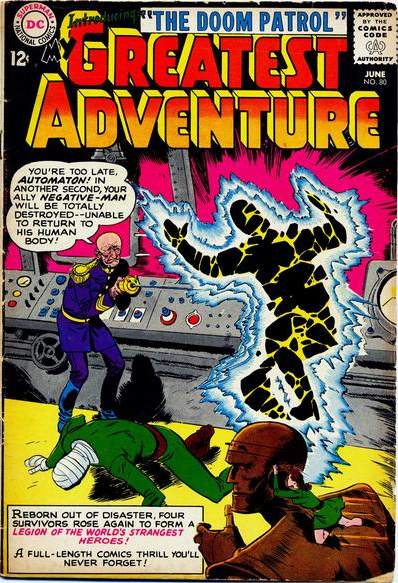
"Duy Tano" at the Comics Cube makes the case.
"Like the Doom Patrol, the Fantastic
Four has a flying character, the Human Torch. Like Negative Man, when
his powers are in effect, visually, he's a pure manifestation of his
power; Negative Man is pure energy, and Torch looks like pure fire. Like
the Doom Patrol, the Fantastic Four's leader is a brilliant scientist,
and its leading lady is, originally, quite shy and ready and willing to
follow. Reed Richards is Mr. Fantastic, the world's most intelligent
man, and he stretches, just like Elastigirl. Visually speaking, in an
action scene, Niles Caulder is missing from the battle, much like the
Invisible Girl, Susan Storm, can be said to be "missing" from the scene
since she's, you know, invisible. And most telling of all, like the Doom
Patrol, the Fantastic Four have an orange powerhouse who can in
absolutely no way even pass for human, and all he wants is to be human.
Like Robotman, the Thing is gruff but really likable". There are
many other parallels (scientist, test pilot, accident with fire, etc)
The biggest difference is that Doom Patrol are outcasts. Except the
Fantastic Four were as well, in the crucial first months, the year
before Doom Patrol was published. The famous synopsis to FF 1
emphasizes their pain and discomfort, something that's core to the Doom
Patrol. The FF were a response to DC's Justice League of America, and
were visually similar to DC's Challengers of the Unknown.. Now that the
FF were popular it seems that DC returned the compliment.
Kirby's original story
Jack Kirby understood this story, but Stan Lee did not. This is further evidence that Jack Kirby was writing these stories, and Stan Lee merely added dialog. Nathan Masters explains:
"In 1962
Watson and Crick received the Nobel Prize for their work on the DNA
double helix molecular model. This was covered extensively in Life and
Time magazines, along with diagrams and photographs of DNA double helix
models, similar to the one shown in this issue, page 4, panel 2. At this
time, molecular genetics was still in its infancy, and the informal
term "building blocks of life" was widely used in reference to DNA,
again, see page 4 panel 2. Here we also have Reed incorrectly calling
DNA molecules "cells," so obviously Jack was perfectly on track with his
art but again Stan just kept getting it wrong because it wasn’t his
idea. Next, on page 12, panel 2, the Mad Thinker says "Here are Mr.
Fantastic's notes concerning his work with DNA, the building blocks of
life itself! Using this information, I should be able to create a new
form of life-- one which will serve only-- the Thinker!" Again
from Kirby’s margin notes."
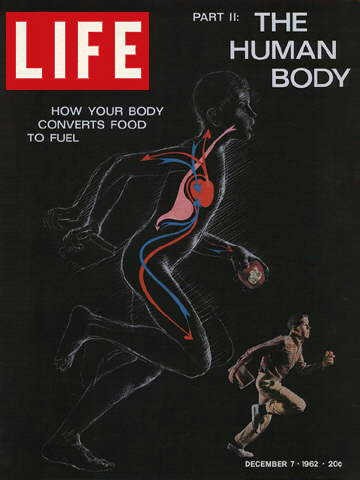
Above: part of a series on biology that ran in Life Magazine in 1962.
This series was in the weeks leading to the Nobel prize awards in
December, where DNA was celebrated.
If Stan did not follow Kirby's plan then that explains all the many problems in this issue:
- The first frame establishes this as night time, yet Stan's dialog later says it's 12:42 pm.
- Reed calls the team to an emergency, and it isn't an emergency,
he's just saying something might happen, but then they all go on
holiday!
- Thinker's first attack is to encase the Baxter Building in a gigantic crystal. Why? That seems to make no sense.
- Stan's dialog focuses on the Thinker's ability to predict, using computers, Yet suddenly the Thinker has invented a giant biological android, with no explanation.
- Stan's dialog puts the emphasis on prediction, which makes a
nonsense of the final page: Reed says we cannot allow for every
possibility, and to prove it he prepared for every possibility!
The problems disappear when we remove the dialog and look at Jack's
story told by just his art. The story is not about computers and
prediction, those are just secondary details. the story is about DNA:
- The first frame establishes this as night time. It looks
like Jack intended this to be one of those "scientist works late to make
his breakthrough" moments.
- Reed calls the team to see his DNA breakthrough. Later the Thinker steals this research,
- The thinker duplicates Reed;s research. This explains the crystal.
For someone like Kirby, with an interest in science, it would be
natural to think of a crystal as the first step in developing chemical
marvels.
- The final step is of course the general purpose "awesome android". This completes the consistent story about DNA.
- The final page shows that artificial life is not as good as real life. Yes, prediction was involved, but that is the means, not the message.
For more about how Kirby wrote the stories, see "who did what". Other changed stories include FF 8, FF 23, FF 67, FF 108, and no doubt many others.
16
Issue 16: Ben's inner conflict. (And advances in medicine and chemistry.)
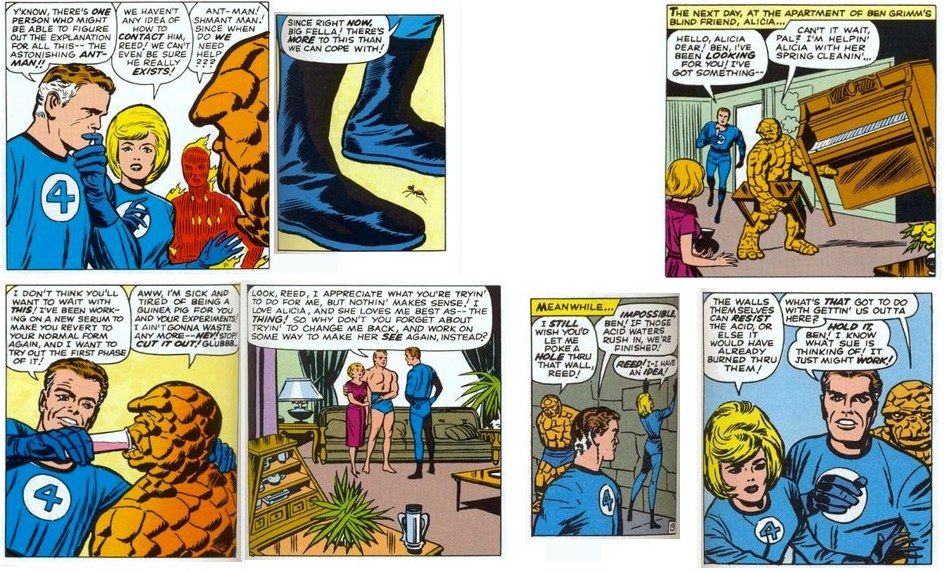
Here we have Ben's hidden, inner conflict symbolized by an inner universe: the microverse.
Triumph and tragedy
As in the best novels, we often have have two major, contrasting
threads at work simultaneously. This is through the first part of
Act 2: the team as a whole is moving from strength to strength,
with bright, optimistic, ever greater adventures, while Ben, as
Reed's natural rival, is beaten down to his lowest point,
emotionally. Issues 16 to18 could be called the Grimm Trilogy.
More on this later.
In issue 16 we delve into Ben's inner conflict. Consciously he
wants to change, unconsciously he doesn't. So he asks Reed to
focus on Alicia's eyesight instead - which leads to issue 19. In
FF126 they try again, and again in FF142. Once again in this story
Reed undermines Ben: he stops Ben from poking a hole in the wall
and just implies that Ben does not think. Sue shows her
intelligence by finding a solution Reed had not considered. Ben
could have done the same if he was alone, he is plenty smart
enough (e.g. he's a test pilot with a high education, and was
always resourceful enough when alone, e.g. later in Marvel Two In
One). But Reed is trying to impress Sue, and unconsciously knows
that popular, confident Ben is a danger to his preeminence. This
is all unconscious, because consciously they are the best of
friends, but the evidence in Reed's behavior is clear enough.
Also in this issue Doom finally conquers a world: Micro-world. At
this stage in his development Doom wishes to cause fear for its
own sake. Later his understanding deepens and he becomes a better ruler,
preferring to be loved where possible.
Alienation
Each member of the cast experiences shrinking. With Sue it even happens on TV. But they did not mention it to the others
- it would be a sign of weakness. This indicates the stresses within
the team. They may be accepted by the public now, but there is still
tension between Reed (who thinks he must run everything) and the others
(who are treated as idiots.)
In this context, note that Sue has dogs in the Baxter building: Sue
is doing her own research: she is not under Reed's thumb. But this may
also indicate loneliness - dogs give her more love than Reed.
Science and wonder
The Fantastic Four is usually about physics, but this issue is about
chemistry (the microverse) and biology (Reed's new medicine). All the
sciences
advanced rapidly in the 1960s. It was a thrilling time, when anything
seemed possible, and that excitement is captured in the Fantastic Four.
"While reading and writing about this issue, I happened to run across Internet
images of beach sand magnified 250 times. It’s amazing how something as
common and unassuming as sand can be so awesome and beautiful, when we
take a very, very close look at it. It made me realize anew that 'not only is the universe stranger than we
imagine, it’s stranger than we CAN imagine' (Arthur Eddington). Above
us, below us, within us, and within the very world we inhabit are other
wonderful worlds, there for the exploring. " (- Crissy)
I couldn't find any sand crystals I could legally use, but did find
this promotional image from Zeiss. The microscopic world is very
interesting indeed.
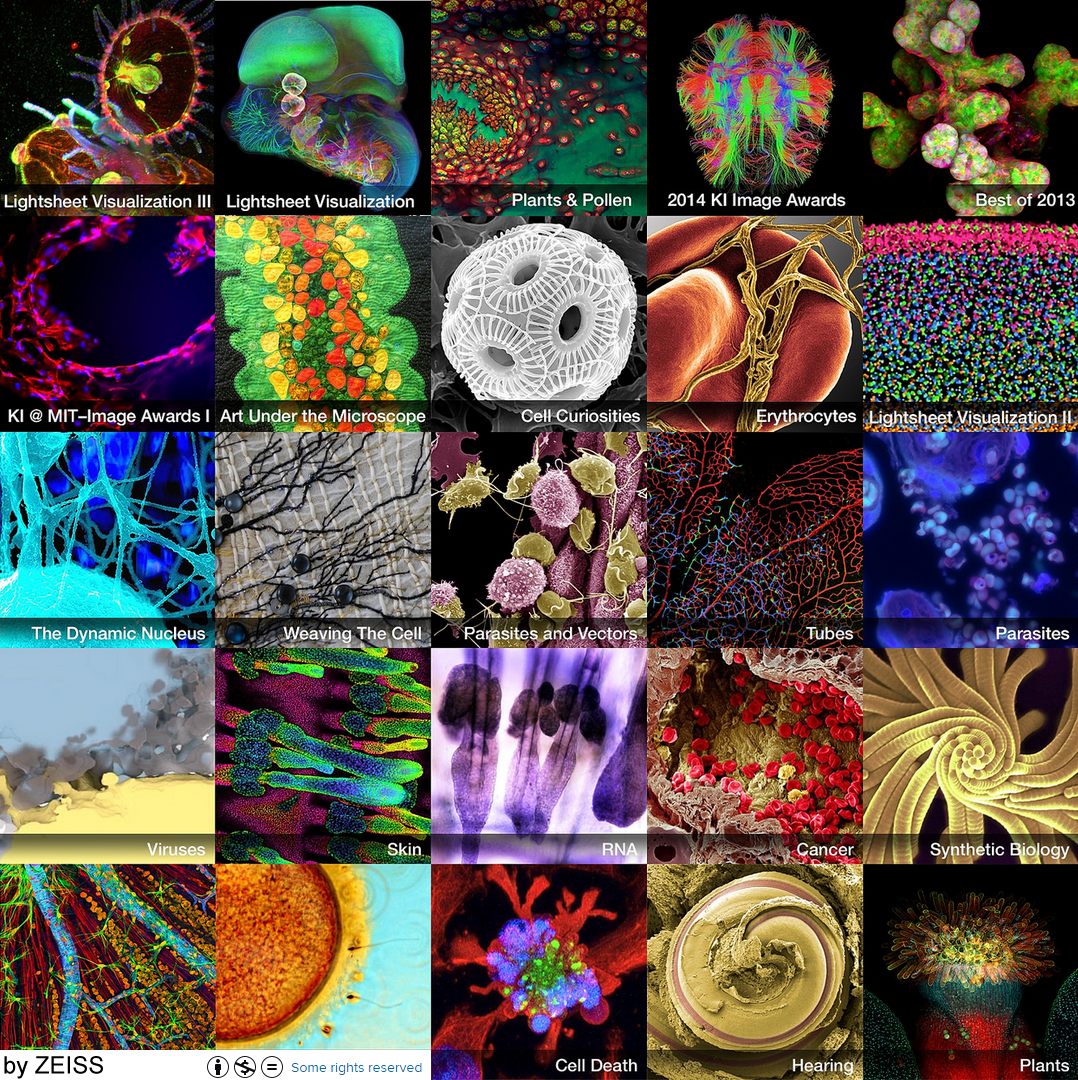
And here's a YouTube video zooming in ever closer to an everyday object, from a video uploaded by 'Major Utah
'. Credit goes (I think) to the research lab (MATEIS) at INSA Lyon, F. The project was initiated by Altomedia.
http://youtu.be/dNvdrpEmS48
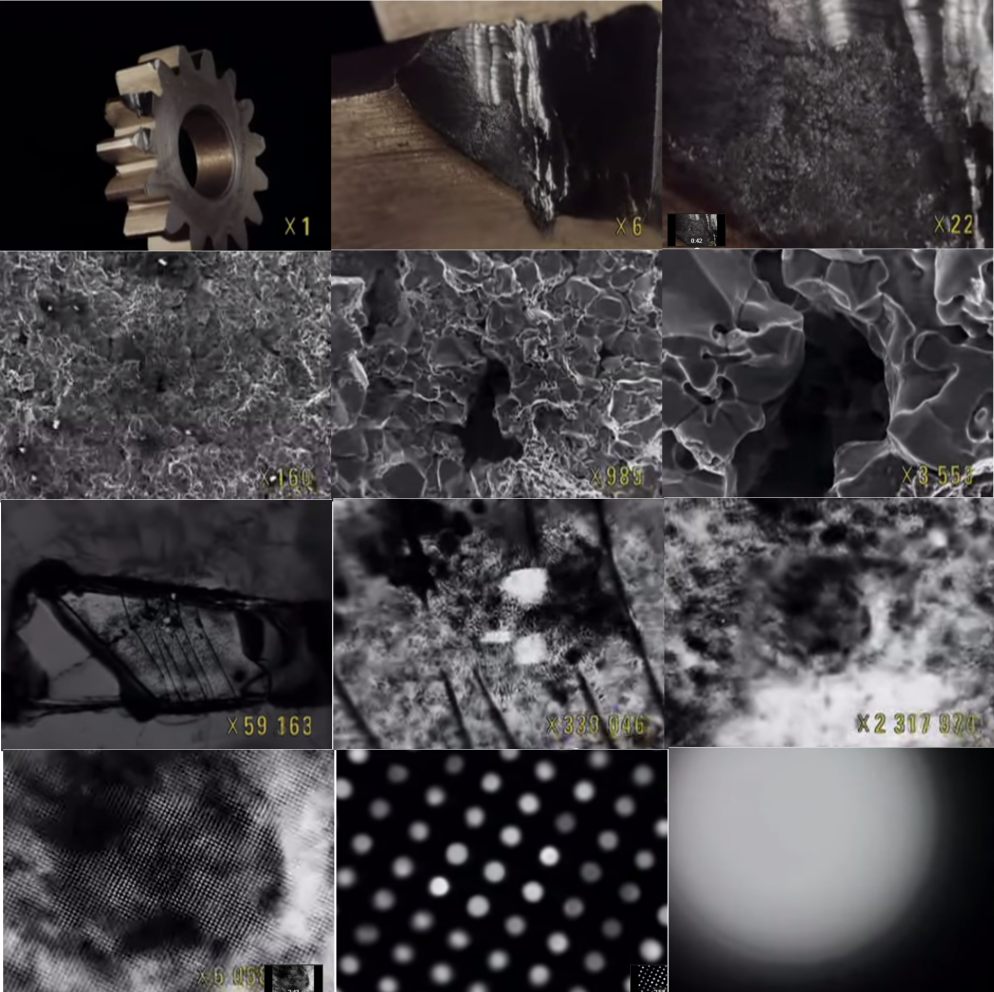
Notice the planet in Subatomica at the very end?
Technology
- Why do they all shrink to the same place?
Mass cannot be destroyed: it must be placed somewhere in another
dimension. This is the first clue that the microverse is not a tiny
world (because the physics would be different) but instead is another
dimension (as hinted in FF282: they only shrink in order to pass a
dimensional interface). Presumably as they shunt their mass into that
dimension the remaining body in this dimension appears to become smaller
and smaller.
Other points to note
- The symbolism of monarchy and scale
Doom is often shown towering over the team, as that his his role as a
monarch (in contrast with the FF's more democratic ways): a monarch is
the giant made up of his tiny subjects. See the notes to annual 2 for
details. Yet in reality, as we saw in FF10, a monarch's life is very
lonely and
pathetic: reduced to threatening people with a gun and smashing an ash
tray to scare them, then the story ends with him squealing for his life.
Then he chose to stay tiny because it was the only place he could feel
important: a small fish in a tiny pond.
"We have to assume that Doom
made a conscious decision to remain in the Micro-World, since at the end
of the story, when a quick escape is desirable, he is capable of
returning to the normal-sized world. He could have returned at any time
after developing the enlarging ray, but instead chose to stay and lord
it over the little people. Doom is so in love with power, he’ll take it
wherever he can find it." (-Crissy)
- Continuity: using scent
From the FFPlaza review by Greg Allinson: "The idea of Sue
using a spray to mask her scent was undoubtedly inspired by FF
#3, where the Miracle Man uses a junkyard dog to find
her."
- Historical milestones
This issue is notable for a number of milestones: the issue
where the team first explore another dimension, the
issue where Doom is established as the greatest enemy of the
team (a position he will always hold), and the issue where
the book decisively moves away from its monster comic
roots.
- Contrast with the Franklinverse
Ant man is the natural person to go to in this case: his visit
evolves naturally from the plot and he plays an active part.
Compare this with the forced crossovers as the Marvel Universe
died in the late 1980s, where crossovers continually
disrupted stories for advertising purposes.
- "Google alerts"
Ant Man invents a forerunner of Google Alerts: if anybody mentions his name then he knows about it.
- Ant Man's mental state
The need to hear his own name, and using a cannon to travel, suggests Ant Man may be mentally unhinged (according to the Wait What podcast, and I tend to agree)
- Mary McBride
"Molly Margaret McSnide" is clearly based on Mary "Molly" Margaret
McBride, the famous radio host who occasionally appeared on TV as late
as the early 1960s. I don't know why they called her McSnide - I take it
that Stan was not a fan. Compare the 1980s version in FF 245.
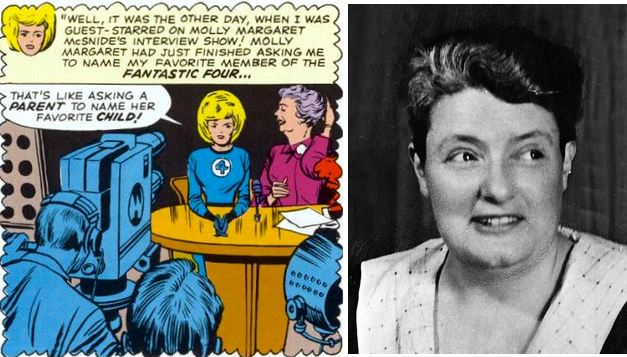
17
Issue 17: John F. Kennedy
Here is an
alternate Kirby cover (for the reprint), showing Doom in his classic
"towering over others" pose. This issue is the turning point: before
this he was just an individual. Now (in his airship) he literally looks
down on the world. After this he becomes monarch of Latveria: no longer
an individual but the embodiment of a nation. In the same way, Kennedy's assassination made him immortal.
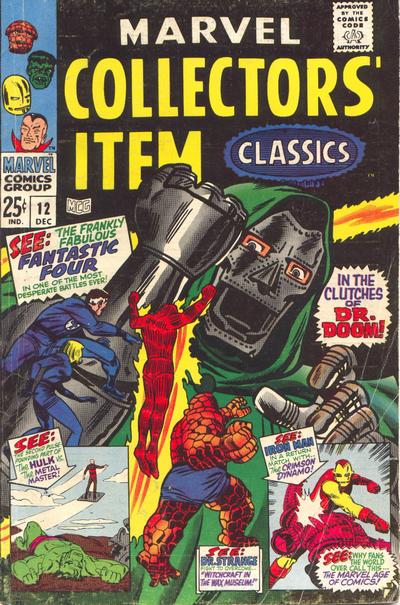
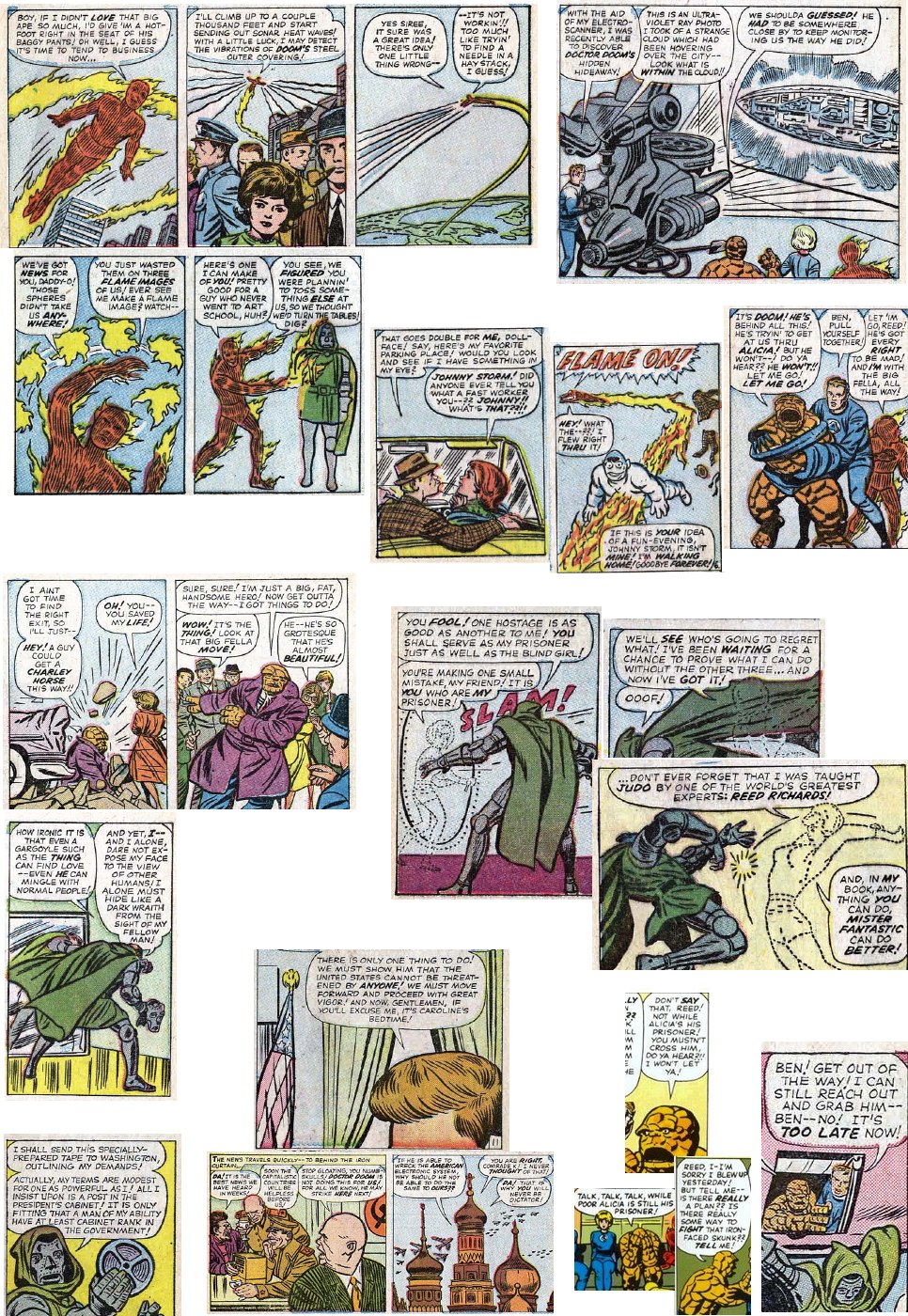
Issue 17 is a masterpiece: one of the greatest Fantastic Four
stories ever told. But on the surface it may appear forgettable or
even weak.
Why the story is easily
overlooked
There are so many elements that no single one stands out, so the
reader might not latch onto any of them, and come away thinking it
was just a generic story. Also, so many new ideas are added that
some are barely explained, and readers may mistake this for a sign
of weak writing. For example, Doom is in disguise, with a beard
and flesh mask over his metal mask, and the team don't notice
anything wrong - even when he shakes hands with each of them,
through metal gauntlets covered in fake hands? Then Johnny uses a
power he's never shown before, creating full colored flame beings?
Readers may dismiss this as bad writing and say "aw, it's just a
comic book, lighten up!" But the Fantastic Four shows time and
again that it is not "just a comic book." All these things are
easy to explain, but are not central to the story.
The explanation if you're interested:
Johnny's flame power has already been shown able
to make flame duplicates, usually of himself (this is mainly
seen in his Strange Tales stories) . He was also shown able to
use heat to refract the air to make mirages appear (see issue
10). Flame burns at different colors at different heats. Also,
Johnny has been shown practicing different skills and uses for
his flame, and finally he can create soot particles if needed.
Put these together and it should be possible, in theory, to
create any color at any light intensity, particularly if it only
needs to fool somebody for a split second and at a distance or
over security cameras. The main significance of this is that it
shows Johnny's incredible potential and his superb attention to
detail when he wants it. There is also the other concept
introduced in issue 10: that the comics we read are filtered
through Stan and Jack's need to entertain. It is possible that
the original facts were slightly different, but they simplified
them in order to fit everything into a limited page count. This
same principle explains Doom's unlikely disguise: disguising is
trivial, nobody doubts that Doom could do it in many ways, so
there is no need to explain how. A single frame showing him
pulling off a false beard is enough to get the idea across and
then the story can move on.
In today's comics, this issue would be
a six issue arc:
- The search for Doctor Doom, ending with the Doom revealing his
face (and more detail would be given to how he disguised
himself)
- The team is helpless before Doom: part 1 would show the FF in
their normal lives, then part 2 shows them uncover the mystery,
and ends with Doom's plans
- The world at the mercy of Doom, and how Ben falls apart.
There's a huge amount in this section - it would be a very busy
comic.
- Star Wars. They track down his lair, gain access to plans of
his craft, devise a solution, and launch their counter attack.
The comic would end with Ben starting to turn back to The Thing
- and too soon! A great cliff-hanger.
- issue 5: the battle on the airship, ending with their being
sent to another dimension
- issue 6: Sue versus Doom, plus how they escaped the dimension
trap: this could easily be ten pages on its own, but it doesn't
move the story forward so Stan and Jack wisely cut it short.
Doom falling through space would of course have been a double
page splash, all very cinematic, starting with extreme close-up
and ending with a Photoshopped real photo of Earth seen from the
upper atmosphere. Doom's ship would of course have been a space
station, as bigger always means more exciting, right?
A tangent: Star Wars
On a slight tangent, there are many parallels between Dr Doom and Darth Vader. FF 17 has perhaps the first obvious example: the heroes discover a secret
floating fortress that sends its destructive rays to doom the
planet, they find its plans and find a weak part in the defenses,
they rescue the damsel, get trapped in a narrow room filling with
sludge, and finally Doom/Vader escapes into space (in issue 6 and
annual 2 he is shot helplessly into space, like Vader at the end
of Star Wars). Note also the parallels with the cloud city in The
Empire Strikes Back, including falling from the bottom of the
floating city and hanging from a pole. George Lucas may well have
have read these comics as a child. Or to be charitable, both The
Fantastic Four and Star Wars draw heavily on classic fantasy and
sci-fi tropes. Either way, the Doom/Vader parallel is obvious, as
we see in Star Wars Tales #9, courtesy of "Again With The Comics":
(note also that parody Reed fits better with Doom than with his
team.)
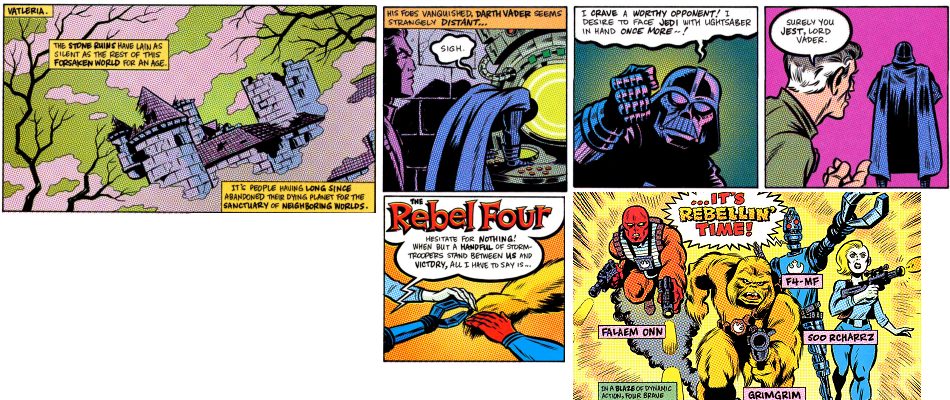
Why this issue is really about John F
Kennedy
It was difficult to decide what to call this summary, and where
to focus:
It's a story about Reed:
This is where Ben completely submits to Reed. Ben is a nervous
wreck and begs Reed to help. Sure, he 's angry at Reed but he's
powerless and Reed knows it. This is a particularly interesting
story because, on the surface, the team entirely depends on Reed:
only Reed can find the secret of the flying robots, only Reed can
find Doom, and only Reed can find a way into the ship. At at the
same time the team show that, if Reed left them alone, they could
have found their own solution. At the start we see that Johnny can
detect odd disturbances, and later we see his other awesome power
(see below). Ben was the one who noted that Doom must have been
nearby: with this insight Johnny could have looked for longer and
found him. True, Reed's detector devices are certainly very
useful, but Doom is causing a world wide problem, and so the team
could have called on other scientists such as Ant man (who helped
them at the start) or Iron Man (the master of electronics). This
must be Reed's secret fear, that his natural place is not as
leader but as support services. How else do we explain his strange
behavior at the end? He pretends that Ben gets in his way, so he
can blame Ben and make himself appear the natural leader. but this
is utterly absurd: earlier we saw Reed stretching into the air
pockets of cement and sliding under a doorway! It is impossible
for Ben to get in Reed's way even if he tried! No, Reed has seen
Ben beg, and does not want to lose his position as the
indispensable one surrounded by fools. All of this is unconscious
of course - as Doom leaped into the air Reed had to make a split
second decision, and there is plenty of evidence that Reed only
wants the best. But to Reed, the best means Reed in charge. Doom
is of course the logical conclusion of this attitude.
It's a story about Ben:
This is the one where Ben is most desperate. We also see that he
can mentally control his changing, but only if the need is
sufficiently severe and involves Alicia. (At the same time he
unconsciously wanted his strength in order to rescue her). Note
also in this issue that many ordinary people see Ben as handsome,
and as a hero. Without Reed treating him as an idiot there is no
reason why his confidence would not be super high. Also note that
this issue follows from the similar situation in the previous
issue: the question of Ben's subconscious feelings regarding
Alicia. These two issues could be the subject of a whole essay.
Note that Doom is also a mirror for Ben: he is lonely and hates
his appearance. Note also that Doom
is already thinking in terms of steps towards world conquest
rather than world conquest itself.
It's a story about Johnny, the
super-man
More than any other issue, this one shows Johnny's awesome
potential. No wonder he's so confident, he's totally dedicated to
his work and constantly finds new uses for his flame. There is
little doubt that he could have found a way to defeat Doom's
disintegrator rays. Think about his range of abilities: to create
duplicates of people (e.g. make Doom think that Alicia had
escaped?), to create heat updrafts capable of shifting massive
weights (see the end to issue 4), to refract light and make
objects appear to be in different places, to create nova heat
(there must be a limit to what the disintegrators can
disintegrate), and so on. Johnny is basically superman. We haven't
seen a fraction of his potential, yet he gradually gave up trying
so hard over the months because Reed only wanted him as a flying
flamethrower. Note also that he is less successful with women than
we might think - this topic comes up again in later issues. But when he is fully in charge and
fully mature then expect basically superman. Now let's get
back to this story. Could they have rescued Alicia without Reed?
Ben has almost no limit to his power
when he needs it (he is basically a slightly smaller version of
the Hulk). Meanwhile Sue could have made the insides of the craft
invisible so they can see where Alicia is hidden. Maybe Doom has
some way of shielding her or providing decoys, but Sue can also
make other danger invisible, so she's still useful. The main
difference between Reed's approach and Johnny and Ben's approach
is speed: imagine what could be done with the full range of
Johnny's abilities, coupled with an invisible berserker-rage
Thing. A completely different approach to Reed's, but not
necessarily less effective. Note also that in future years he
would have Crystal's power (with access to advanced Inhuman
technology) and Lockjaw to just teleport inside the ship. Or
Lockjaw could trace the lost Alicia. Reed wants to be the one
indispensable super-being, but the message of the big story is
that heroism doesn't work that way.
Sue makes the boys look useless again
In issue 15 we saw how Sue wants a life of nice clothes, where
she
can spend her life meeting people in regular charity work rather
than a life of unrelenting danger and duty. Here she begins to get
it, but of course her team duties get in the way. Once again Sue
makes the boys look useless. They can't defeat Doom, so merely wait in
case Doom comes out. What a plan! Meanwhile Sue leaves, finds Alicia,
rescues her, and defeats Doom single handed. All that time Reed didn't
even notice she had gone!
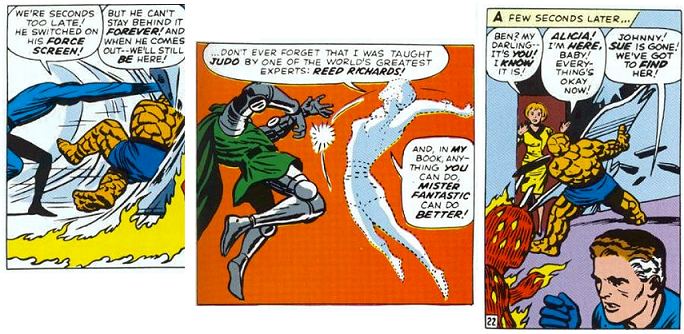
Why does Sue credit Reed, who has shown no evidence of ever knowing
Judo? It's the perfect way to weaken Doom: force him to make a mistake.
Doom hates Reed, and considers Sue to be weak. Sue is saying "Reed has
beaten you! Yes, Reed! He didn't even need to come in person, he sent a
female to do it!" What humiliation! What a magnificent woman!
Then why is the story about
Kennedy?
The overriding theme of this story' like all the issues from 12 to
20, is optimism and confidence. Each one of the team is superb!
They are magnificent! Both as individuals and as a team. We also
see Kennedy himself at work, efficiently and powerfully, and he
has the right priorities (as Reed will finally learn to, in Act
5): Kennedy puts his family first. Even Doom, in a world where
Kennedy exists, merely hopes for a place in his cabinet rather
than immediate world domination. This is the most joyful of all
the stories, despite Ben's utter despair at the start (which is
balanced by his joy at the end). This is a story of the early 1963
zeitgeist, of he period known as "Camelot" (notice the man dressed
as one of King Arthur's knights at the start, and the poetic
significance of Doom's castle in the sky). In Camelot everything
was going to be wonderful, every problem solved: the space race,
the arms race, civil rights, everything!
Then just after this story was finished, Kennedy was
assassinated. And in issue 21 we have the darkest story of all,
The Hate Monger.
Doom and human motivation
For an overview of Doom's development in his twenty appearances see his own page.

Doom's behavior in this issue is sometimes questioned (e.g. by
Greg Allinson in his review on FFPlaza). Quote:
- "Why did he go through all that work with the followers when
he was standing right in front of the FF in a disguise that
fooled them? Wouldn't a sneak attack make more sense?"
- "Why not slip irremovable explosive discs on them and force
them to do something to help him? That seems more like Doom's
style than sending balloons to harass them."
- "Why was Doom dressed as a janitor? I mean, it's not as if
he's got an army of sophisticated robot doubles at his disposal
or anything.|"
- "If he's trying to blackmail the President, why did he ask for
a cabinet position? Was he planning on slowly killing off
members of government until the presidency fell upon him (which
I don't think is even possible, seeing as Doom wasn't born in
America)? Wouldn't control of America (or at least a major
American city) make more sense?"
This raises the key question: what is Doom's goal? To control the
world? Then he should choose economics. To kill the Fantastic
Four? Then he should buy some poison gas. No, as his name and
costume reveal, these are merely a route to his real goal: to
feel important.
Maslow's
hierarchy of needs
As Abraham Maslow observed, we have many needs,
and feeling important ("self actualization") is at the top. Doom
uses flying dummies (almost certainly based on Ovoid technology)
to both embarrass his enemies and prove his superior technical
abilities. He tricks them in person to show how clever he is. He
wants to be part of the cabinet so that the most powerful men in
America can see that Doom is superior: that with only limited
tools he can dominate and control them. He wants them free to
oppose him, so his constant triumphs are all the more impressive. Doom is a study in the need to feel important.
Why does Doom want to marry Pearla?
"No, he doesn’t need a woman…but perhaps…he wants one? Perhaps he looks
at Reed Richards and his lovely girlfriend Sue Storm, and secretly yearns
for the same kind of relationship. If he wanted Pearla, all he would
have to do is take her; he could force her to be his wife. But he can’t
force her to love him. And maybe that’s what he’s most
after—unconditional love." (-Crissy)
In this issue we see how although Doom claims to need nobody really he
hates himself and is lonely. This self hatred is explored in detail in FF199, prior to Doom's final defeat.
Does Doom keep escaping?
It
might seem at this point that Doom always escapes. But in fact he only
escapes twice in his entire career (FF5 and in this FF16-17 two parter).
The other two times, FF6 and FF10, all the evidence suggested he was
dead. In later stories he does not need to escape: from Annual 2 he is
head of State so has diplomatic immunity, The concept of national laws
getting in the way of justice is a powerful one, and central to the
Great American Novel being an epic of nationhood.
The symbolism of Doom and cages
Both times that Doom escaped he did so into the sky. It had to happen
twice to drive home the symbolism through repetition and dramatic
contrast. Nobody can cage Doom - he is free, like the birds! And yet he cages himself
behind his iron mask. He represents old world tyrants: in theory they
have power to do whatever they want, but a tyrant's freedom hating ways
mean he lives in a cage of his own making: The FF have genuine fans, and
enjoy the life of celebrities (as we see here in FF17), whereas a
tyrant must always be afraid of enemies because everyone hates him.
Who defeats Doctor Doom?
A quick Dr Doom score card:
-
FF5 - beaten by Sue.
-
FF6 - beaten by Namor (friend of Sue).
-
FF10 - beaten by Johnny and Ben.
-
FF16 - beaten by Sue, showing she can be smarter than Reed (how to escape the trap) and then Sue grabs Doom's gun.
Notice a pattern here? Doom may hate Reed, but it's Sue who defeats him almost every time.
Technology
- Massless robots; Doom's disguise
How can the robots float through walls? How can Doom fit into a disguise
that is smaller than he is? In the previous issue Doom began to lean
the secrets of mass shifting (for shrinking: see superscience
for details). Both massless robots and slight shrinking are examples of
mass shifting. For more mass shifting see Doom's next appearance in
FF22, where he experiments with making people stronger, and jumping to
other dimensions.
Other points to note
- Sexual symbolism
Ben and Alica's relationship has always had Freudian overtones. She
looks exactly like Sue, who plays the mother role in the group. She is
fixated on her father who always controlled her. Ben is afraid that his
powerful, ugly, earthy male form will hurt her vulnerable female form.
Alicia uses her hands to experience via touch and create beautiful
images, emphasizing her sensuousness. In this story she is carried away
into the clouds (usually a metaphor for ecstasy). Ben must rescue her by
using great self restraint in order to penetrate her ship without
letting his body expand, or that would cause disaster. The imagery looks
like a sperm approaching an egg.
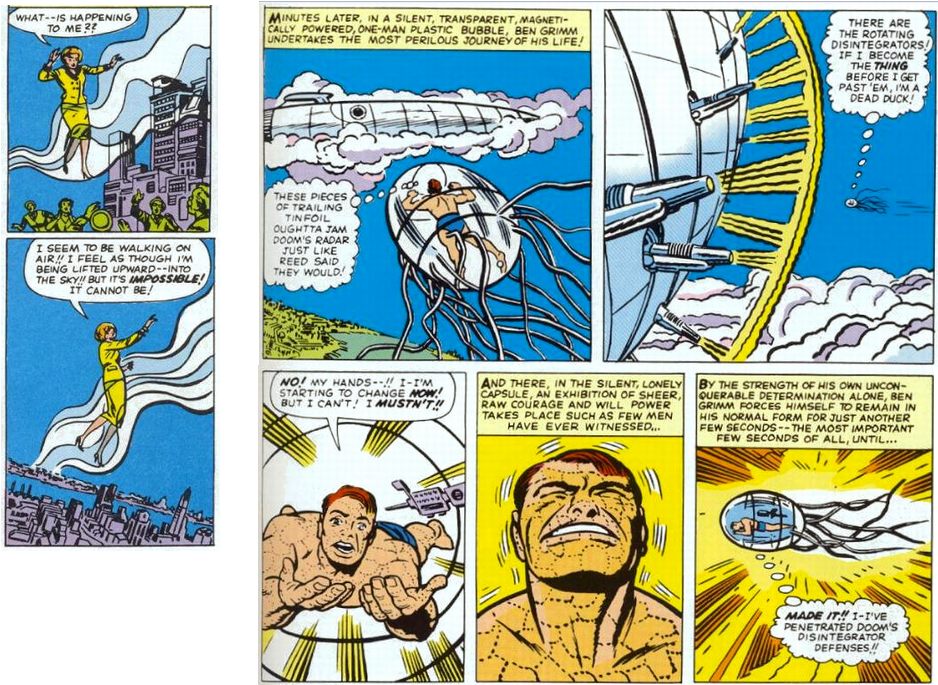
"While Ben travels in the 'silent, transparent, magnetically-powered one
man plastic bubble,' looking more than anything like an illustration
from a 5th grade health film about reproduction, he exclaims 'Made it!!
I’ve PENETRATED Doom’s disintegrator defenses!' This is not the first
time I’ve noticed an image or remark that could be misinterpreted by
'dirty minds,' and it makes me wonder if anyone has ever written a book
or done a scholarly paper on Freudian and sexual symbolism in the world
of Marvel Comics." (-Crissy)
18
Issue 18: the Grimm Trilogy ends
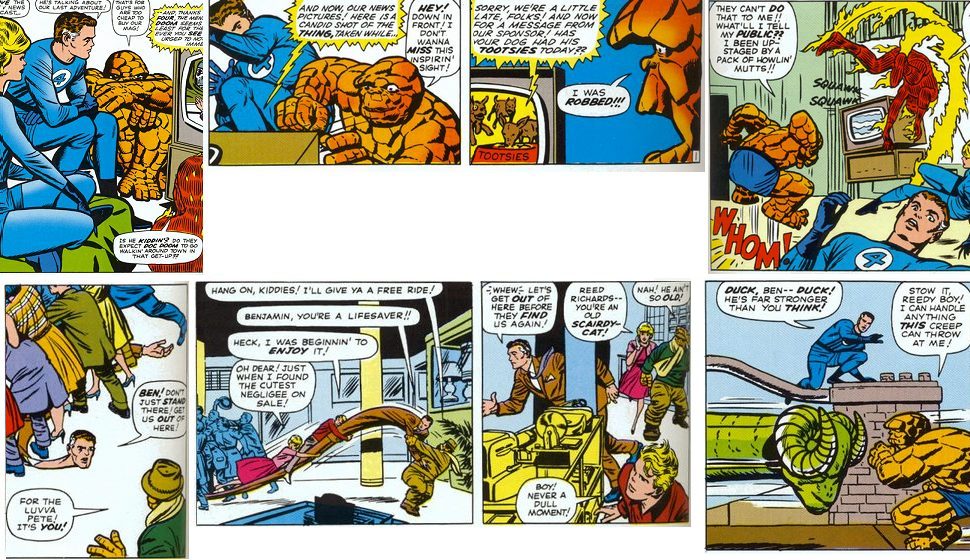
Issues 16-18 can be seen as The Grimm Trilogy: this is where
Ben's loss of confidence is complete. He still has supreme courage: he will never give
in. But this is the courage of the man who sees no hope. He can
take pain, he can keep going when a sane man would give up, he can
find superhuman reserves of strength because he does not value his
own life.
- In issue 16, Ben gave up any (conscious) hope of being human.
- In issue 17, he fell apart emotionally - he was powerless to
help Alicia, and totally dependent on Reed.
- In issue 18, he is like an infant. He assumes the fetal
position and has a childish tantrum when his TV program is
cancelled. This was a war hero and test pilot with severe
emotional damage, folks.
- The intelligent test pilot accepts the role of muscle-bound
fool. This is the first use of the word "clobber" ready for
"it's clobberin' time" in FF22.
We are reminded that in reality Reed is just as dependent on Ben
as Ben is on Reed - Reed feels really uncomfortable in a crowd,
especially when he has no control (hints of autism?), and Ben
takes the opportunity to return Reed's "kiddies" jibe from the end
of issue 15. Remember that there is no malice here, the group
genuinely care for each other. But on the unconscious level we
have two alpha males competing, and the scheming upstart (Reed)
has finally defeated the natural leader, the popular man's man
(Ben). Reed still takes every chance to undermine Ben (again, not
intentionally), such as saying he should duck when the battering
ram comes. Ben is not a ducker! Sure, the ram hit him hard. But
that's how Ben fight: he gets hit hard, he comes back and hits
harder! But Reed is always making Ben think he's weak, and that he
should hide and run.
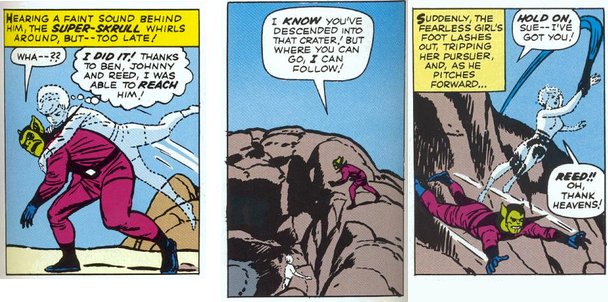
Finally, note Sue's supreme courage in one of her last outings
before she learns how to create a forcefield. The boys are vastly
more powerful than her, physically, and the super Skrull is the
most powerful enemy they've faced. He would not hesitate to crush
her like a flea, and he has the power to do it in a dozen ways: if
she doesn't get the device on him instantly, or if it doesn't
work, then she's dead. She may be dead anyway, even with reduced
power he could crush her. Yet she leaps on him to attack! Then
uses herself as bait! If courage is measured by putting yourself
in danger then Sue is the bravest person on the planet, and the
others, with their super powers to protect themselves, are not
even also-rans.
Criticisms
- Trapping him in the crater
The Skrull is trapped inside the crater at the end. Is this
practical? He's a shape shifter who can shrink - as the fake Sue did in
issue 2, so maybe he will find a way out through a crack, or
even bulk up to exert force on the rocks.
But Reed had plenty of time to study the
Skrull craft they captured in FF2, and this clearly gave him
enough insight into Skrull physiology to create the force beam
jamming device used in this issue. He will have a rough idea of
their limits. Johnny's heat can fuse rock to be as smooth as
glass, and would have prepared the crater, and added sufficient
mass on top to prevent escape.
- Cruel?
Is it cruel, would he starve to death? No. A body that can
radically alter its cells will of course be able to hibernate.
- Does he actually lift it?
The generator lifting scene has been criticized as it might look like the
Super Skrull is not actually moving. But it is clear that he is standing
on a platform that is raising up. He is lifting the core from the
platform.
And two related criticisms from ff1by1.com:
- A machine cannot lift the core?
The skrulls said a machine cannot "perform such a feat" as the
super-skrull does, yet he stands on a platform that lifts him and the
weight. Clearly "such a feat" must include walking over to the
generator, lifting it, then walking away again.
- Deus ex machina?
The power beam at the end is a deus ex machina? No, we just
saw a version of thw power beam in the previous issue: the transport
bean that lifted Alicia into the sky. As we will see in later
issues(e.g. with the Invincible Man), transporter beams and power beams
are the same technology. More importantly, everything in the FF is about
realism. Clearly the super-skrull's abilities are so extreme that it is
unrealistic, unless helped by some outside force. So the reader has all
the clues needed to solve the mystery before the final reveal. The next
time we see a being with such power it's the Silver Surfer, who relies
on chanelling an external source, the Power Cosmic. In FF 250, where
Gladiator appears to have the same absurd levels of power, Reed knows it
is impossible, and looks for (and finds) another explanation. But once
realism
ended after FF333 these limits of course no longer apply, and
random new characters (such as the pumped up Hulk, the Sentry,
etc.) have apparently no limits. If other comics show beings
with that kind of power then we know they have abandoned realism.
Other points to note
- The zeitgeist
The title "A Skrull Walks Among Us" is probably from the 1956 movie "The
Creature Walks Among Us", a sequel to "The Creature From The Black
Lagoon" in which the creature gains the power to breathe air, so can
hide among regular people. The cold war analogy is obvious (communists among us)
- A two part story
In Greg Allinson's review on FFPlaza, he says this would work
better as a longer two parter. I read this first in
exactly that format, in Britain's Mighty World of Marvel 39
and 40, one of the first American comics I read. i loved it and
still do. The story benefits from the larger page size and lower
color, giving the story more gravity: the page where the
Skrulls first demonstrates his power was particularly impressive:
you need to take time over each frame, and pause between them for
full effect.
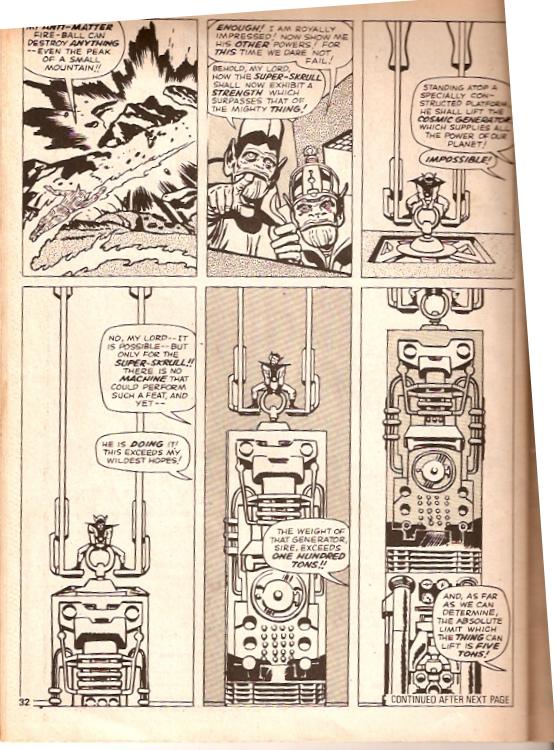
In British comics a home grown adventure was normally two pages
long, so ten pages (half an American comic) felt like a very long
story. We were used to analyzing every frame, not flying past
them, manga style. This story also benefits from being read in two
parts with a week's wait in between. An under-rated classic.
- First "super"
This is probably the first time Marvel used the word "Super" as a
prefix, something usually a trademark of DC (then called National).
Given that their comics were distributed by National, who could have
reacted angrily, this was a bold move and reflected Stan's increasing
confidence as sales figures poured in.
19
Issue 19: Ben's tragedy
Alternate cover:
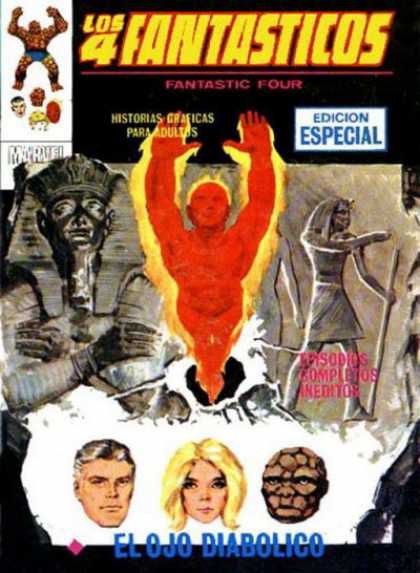
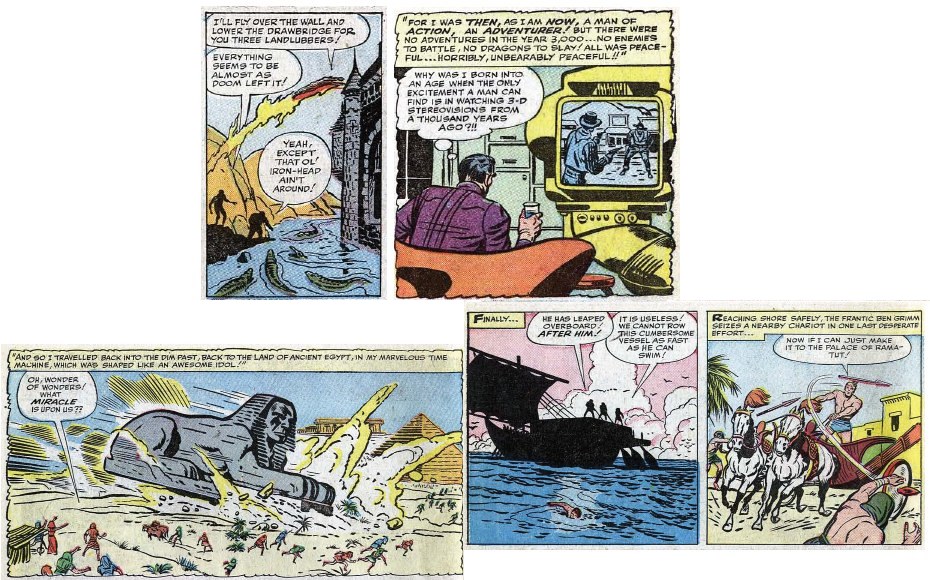
I try to avoid commenting on my personal enjoyment of stories where
possible, or this project would be ten thousand pages long! But
sometimes
you just have to gasp with joy at the richness and wonder of it
all. There's so much in this comic! A man tries to save his blind
girlfriend's sight; a mystery encoded in ancient hieroglyphs; a
castle owned by a high tech master of black magic, with a
crocodile infested moat; a future sci-fi world where they watch
cowboys and Indians; pirates; a chariot race; the secret of the
sphinx; a time machine; ancient Egypt... with ray guns; Reed
leading an army; our heroes as slaves... is there an award for the
biggest number of amazing spectacles in one comic? If you're a
professional comic writer or artist you may want to avoid this
issue. You'll never be this good, and it will just make you
depressed. Somewhere in the wreckage of the comics industry even
now there stands the remains of a colossal statue, and inscribed
in stone around the feet are these immortal words:
"My name is Jack Kirby, King of Comics. Look on my works, ye
mighty and despair!" Face it, ordinary writers and artists, you
ain't going to make anything this beautiful, not with so much for
so little money, issue after issue. You might as well get another
job, ya hacks.
Incidentally this is how real education works. Sure, they spell
"Pharaoh" wrong (as they did in a early Iron Man story at around
the same time), but it makes the ancient world exciting! And after
that, you have the basic building blocks seared in your mind, so
learning about real pharaohs is easy.
Comic readers tend to remember the period from 44 as the
invention of major characters, but this sequence of issues is just
as rich: issue 18 brings us the Super-Skrull ( a favorite of many
fans, and of writers such as John Byrne). This issue, FF19, is the
ur-text form Kang, Immortus, Dr Doom's Time Machine, Nathaniel
Richards, and all the time travel stories that place throughout
the Marvel Universe. This individual issue has served as a
backdrop to several other stories over the years, where other
superheros and teams (such as the West Coast Avengers) are present
but unobserved, in the style of Back To The Future 2 and 3. The
reader is left to decide whether those other stories are canon -
personally I see them as proof that The Fantastic Four is where
the ideas are, and other comics exist in its shadow.
OK, back to the long term story
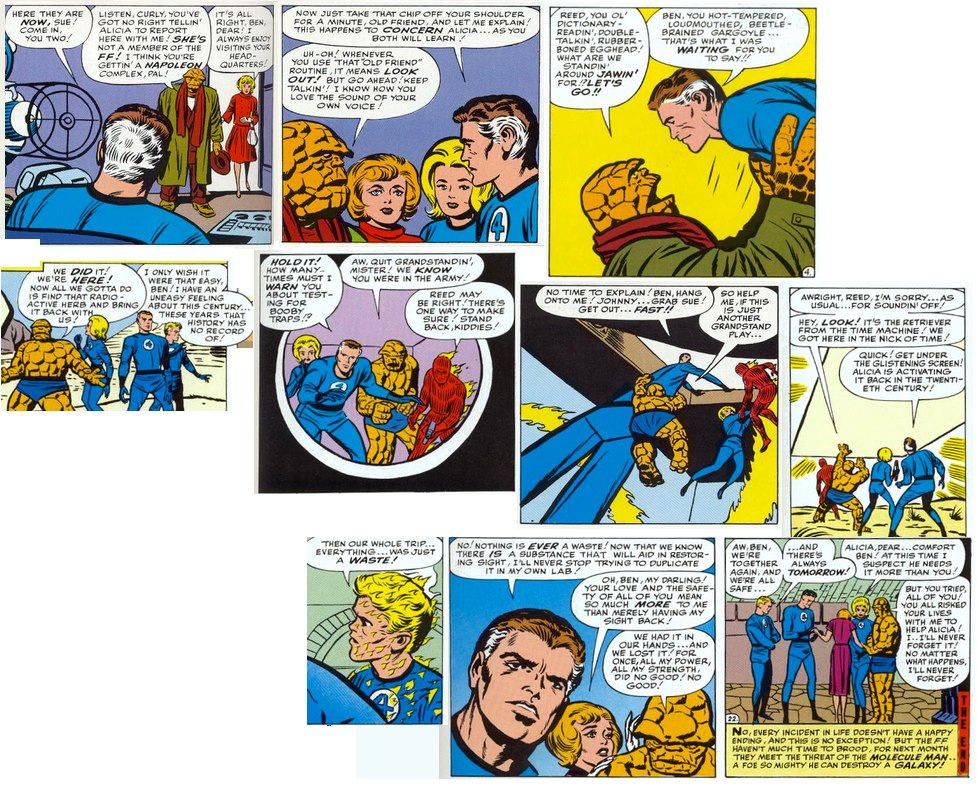
This completes the mini-arc about Ben and Alicia. After the Grimm
Trilogy, where Ben gives up hope, salt is rubbed in his wound. He
seems to at least have fund a way to cure Alicia (his concern in
issue 16, remember?) and it seems so hopeful.... then fails. The
new deeper tragic level is embedded. Reed continues to keep Ben's
confidence low. Note that Ben's insults are veiled compliments (he
mocks Reed for being too smart and to flexible), whereas Reed's
insults are just insults. The story is about Ben's dependence on
Reed (for Alicia's cure), where Reed raises Ben's hopes and
(through no fault of his own) dashes them.
Criticisms
- Why not the future?
Why doesn't Reed just travel to the future where medicine is
better? Perhaps he isn't thinking about Ben's needs as much as
we might hope, but there may be an innocent explanation. Some
theories of time travel say that it can only go backwards. Note
that the team never go forwards in time (except when returning
to the present). This is one more area where the book is
naturally realistic (the superpowers are really a very tiny part
of the bigger picture). And on the topic of realism, note how
nothing is really forgotten: Doom had a castle with a time
machine, and many issues later it's still there. And it isn't
packed with booby traps: this is pre-Ovoid technology, so the
early Doom was not that advanced.
- Why not the past?
Why not just take Alicia back in time? Clearly there is great danger in time travel. Super powered beings can survive it better.
- The boat
Why can't the boat catch up with the swimming Ben Grimm? It appears to take too long to change direction.
- The monarchy trope
The "ff1by1" site
criticizes the book for repeating the image of free Americans
trapped by backward monarchies (e.g. the throne scenes in the
micro world, ancient Egypt, the Mole Man's kingdoms, etc.). But
that is kind of the point: the FF is the iconic story of
America, the story of free people looking to the future,
fighting for independence from the monarchies and attitudes of
the past. See the commentary to issue 20 for more examples.
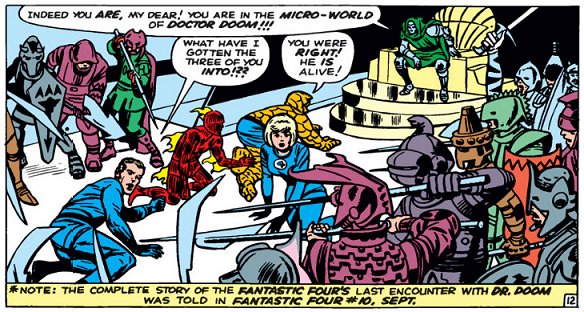
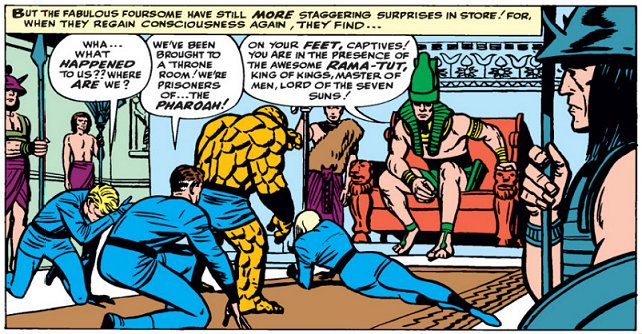
Other points to note
- Reed's promises
Reed says he will never stop trying to duplicate the substance
that restores sight. But he never even tried, as far as we can
tell. He sometimes says things just to make people feel better,
with no concern for truth. Compare the end of FF7 (about the
enlarging ray).
- Ben's first cigar
After the depression of issues 15-18, the story begins with Ben trying
to regain his self esteem: he spends more time with Alicia and ignores
the emergency flare. In keeping with his returning confidence we see him
with a cigar for the first time. Of course, the confidence will be
taken away by the end of the issue. The next time we see him with a
cigar is when his confidence returns due to mind control. After that we
see him with a cigarette when he's worried about Alicia. Months later
when his confidence begins to climb permanently a cigar becomes more
common.
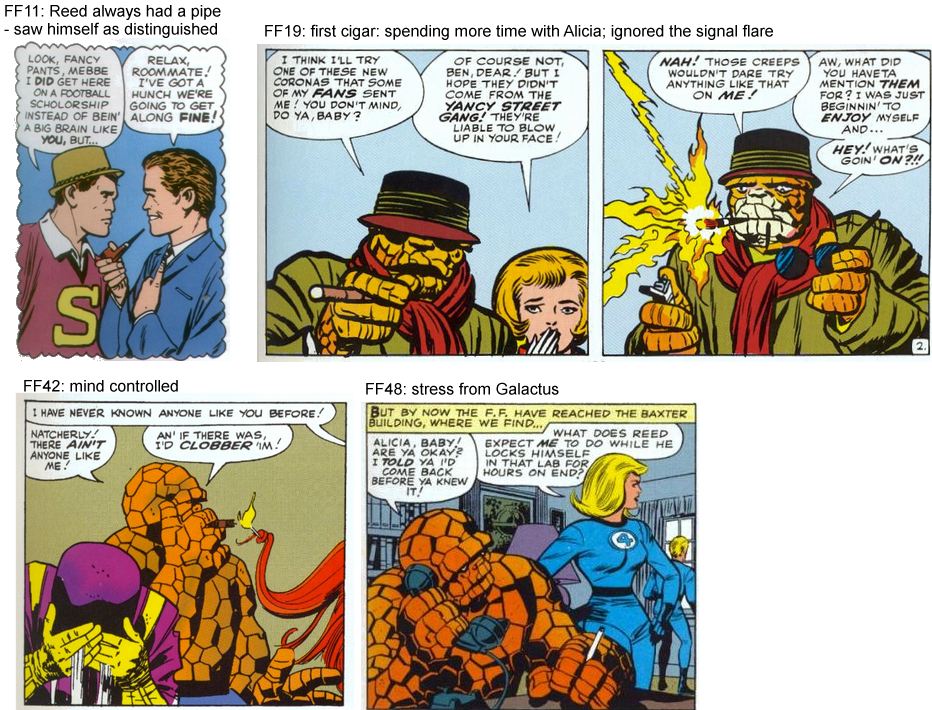
20
Issue 20: the atomic bomb
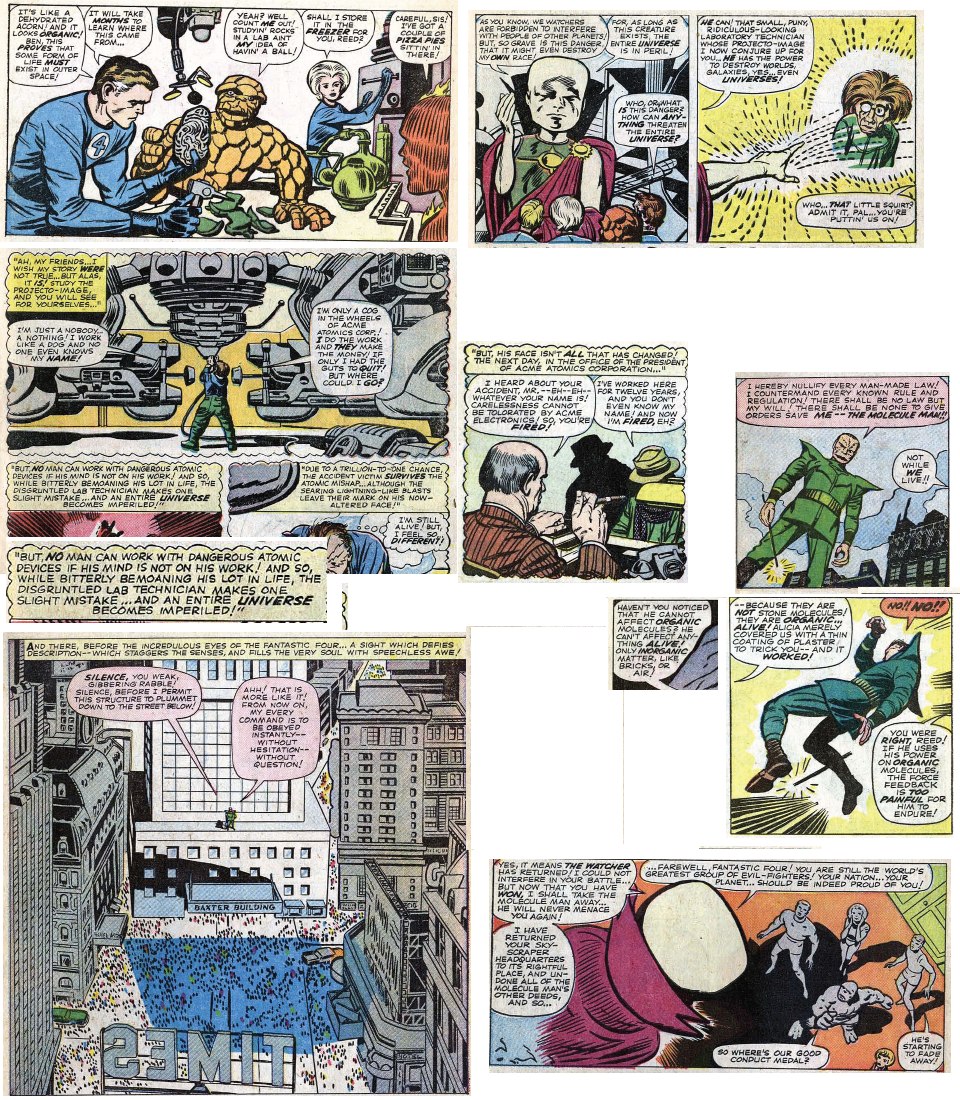
This, the climax to the Kennedy stories, is essential to
understanding the mystery
of the team's superpowers. Note the similar covers. The
links won't be obvious until the very end, in FF319, but see the commentary to FF187 for
the clues.
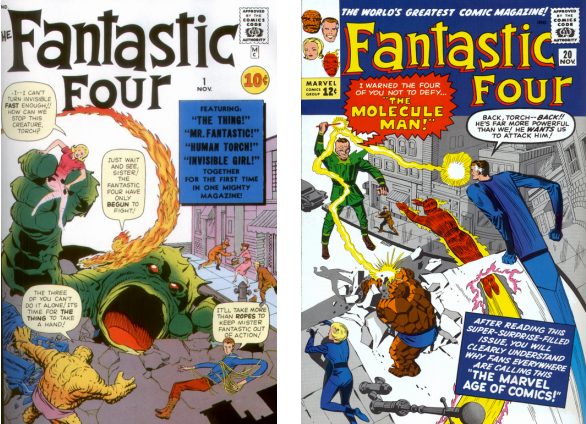
The first homage to issue 1
Over the years, many magazines have payed homage to the iconic
cover of FF1, but this is the first. Note the street with the
awning, the squared paving and the man in brown (the poor guy,
he's probably thinking "not again!"), the perspective and framing
(villain top left, heroes at bottom of page, Reed at the right),
the villain in spiky green costume with his right arm raised. But
this time it's the heroes who are breaking through the street.
Unused cover
From Jack Kirby Collector 9 (captions by Stan Lee)
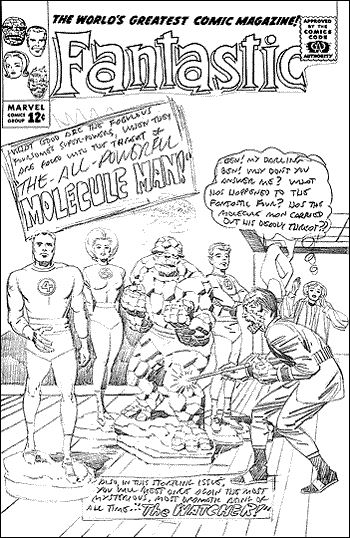
The zeitgeist
The period of Kennedy inspired optimism and wonder reaches
its peak with this issue. Apart from Ben's tragedy these are
stories of tremendous discovery and beating incredible odds. Note
the ever increasing scale of the stories: After returning from the
Moon they first defeat the crime bosses, then Doom, then their
most powerful ever individual foe, then an emperor with all the
knowledge of the future, then somebody who's almost Galactus level
(according to the Watcher). Each adventure is bigger than the
last. Where do we go from here? Real history will soon step in,
and rotate the zeitgeist by one hundred and eighty degrees.
A 28 year subplot
The Molecule Man will become crucial to our understanding of the origin of superpowers and
the Fantastic Four's origin in FF1, and comes to a conclusion
right the end of Act 5, in FF319. Note it is the Molecule Man who
makes Reed decide to give up in the epic issue FF188, and he
learns humility before Reed does.
The American Dream: ordinary workers
I'm trying to avoid a run down of all four themes in every single
issue, but this is a new twist: the Molecule Man was a bad
employee, he didn't work hard, and that's why he became a villain.
Then he tries to rule over Times Square, the symbol of American
corporate success: the bad worker threatens everything. Also note
that when he gains power he gets his hair cut.
An alternate reading is that this is the tragedy of the common man.
It is not the Molecule Man's fault that he fails. Even when the worker
gets ultimate power, and simply wants his turn to be an elite, fate still conspires against him.
Motifs
Note the motif of monarchy being a Bad Thing in America. Almost
every enemy wants to be a monarch. Even the Puppet Master dreamed
of sitting on a throne, wearing a crown. Namor of course was already a
monarch, and Doom, befitting his genius, actually achieved his goal.
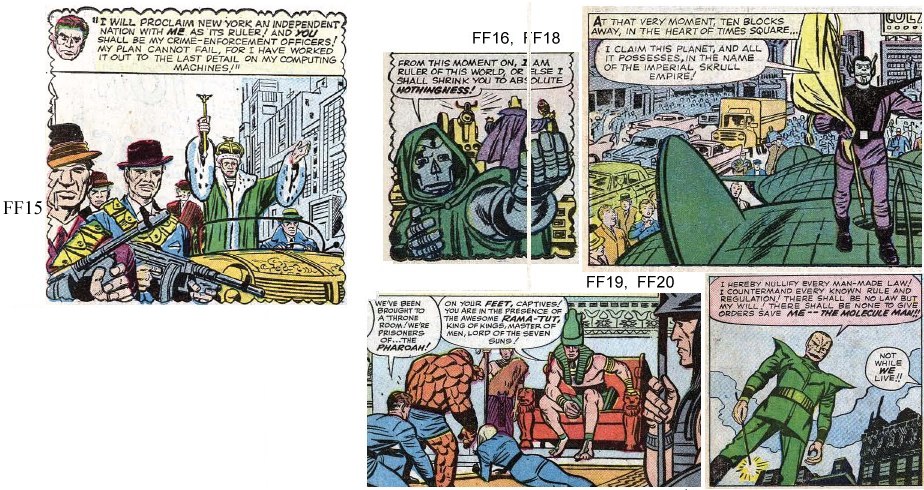
A man who can control atoms...
can control anything
"The searing lighting-like blasts leave their mark on his now-altered
face". The blast removed most of his hair: he had thick, wild hair when
the bast hit, and was left with a tiny amount right on top. This and the
scarring reminds us of the radiation burns on victims of Hiroshima and
Nagasaki. There is also his use of a wand: the lightning scars and wand
are all very Harry Potter-ish (see notes to FF189, where Klaw looks just
like Voldemort). The Molecule Man's costume has the shoulders of an
eastern magician (think Abanazar in Aladdin), but the lower part is the
uniform of a factory worker. So the Molecule Man, as his name suggests,
is a symbol of the unlimited potential of atoms: atomic bombs and atomic
energy. This potential is so huge that the Watcher must get involved.
Note how his ball of flame looks like a photo of an atomic explosion at
the moment of ignition. Atomic power was at first a harsh,
unsophisticated power that could not interact well with humans (hence
the ending of the story) but give it time!
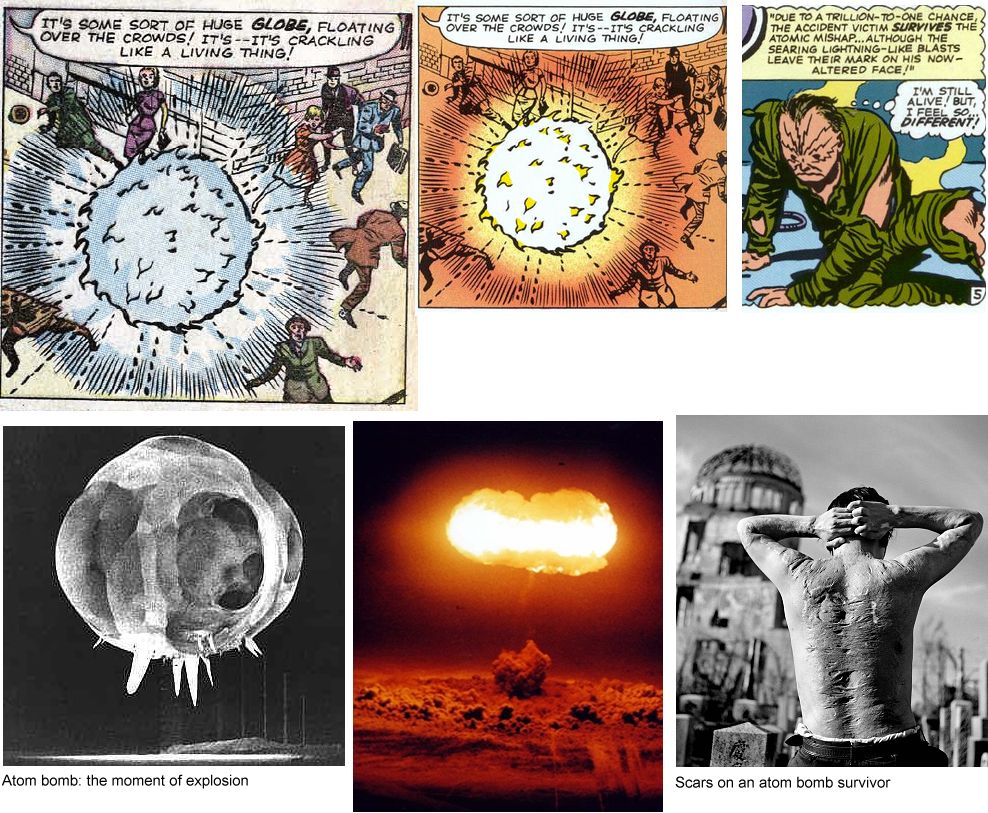
Other points to note
- Biochemistry
Biological molecules are far more complex than other
molecules, due to the mathematics of how carbon can combine in
ways that other atoms cannot. A single biological molecule may
contain thousands of atoms in complex folds that affect how they
interact. This explains why the Molecule Man hasn't learned
to control them at that stage: he seems only able to make
changes if it results in a stable result. Later his experience
increases and he can do more.
- Life in outer space
The story begins with Reed discovering life from outer space.
Some reviewers consider this a mistake, as by this time the FF
have met the Skrulls and the Watcher. But the significance is
made clear on the first page: this is life in the vacuum of interstellar space, not
from a planet. Its
casing protects it from the vacuum and even from impact on
Earth. Given that space is vastly bigger than the few planets
that support humanoid life, this is a major discovery. Note that
not all life is humanoid or anything like us.
- Letters
This issue contains a letter from the young George R. Martin,
later to become a Hugo and Nebula winning author. His letter
mentions another letter by Paul Gambaccini - later a radio and
TV personality. Other writers from this period, such as Steve
Gerber and Mark Gruenwald, went on to become highly influential
in the world of comics (Gerber created Howard The Duck, and
Gruenwald became Marvel's go-to continuity man, the model for
the Time variance Authority characters created by Walt
Simonson.).
- Will Eisner
The excellent "Wait What" podcast pointed out that the Molecule Man's origin is very much like that of a Will Eisner character: like a villain from The Spirit.
- Steve Ditko
The frame where the Molecule Man creates a transparent barrier (so the
police can't shoot him) is drawn by Streve Ditko. Stan often asked for
last minute changes, and whoever was in the office at the time would
draw them (for no pay).
21
Issue 21: Civil Rights: no more light and fluffy
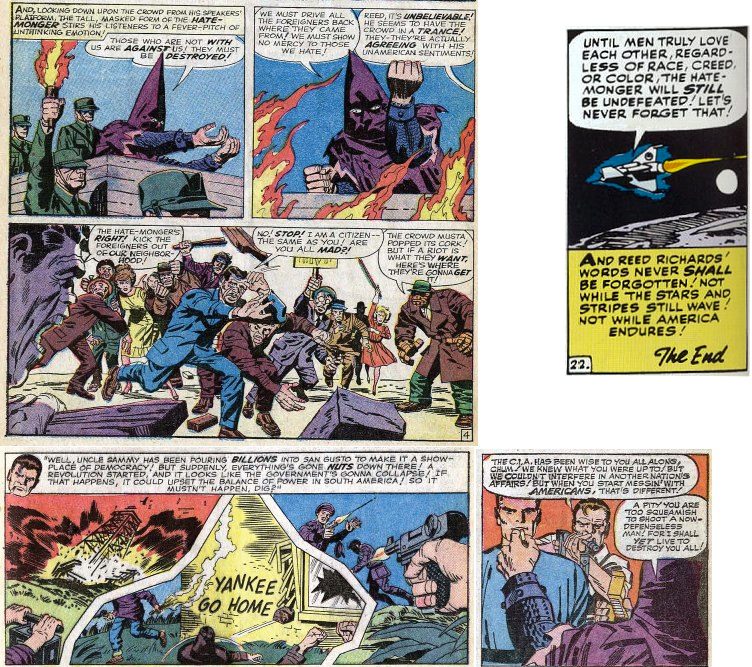
The Zeitgeist dramatically
changes
In the summer of 1963 civil right came to the top of the agenda:
in June 1963, around the time this issue was written, Kennedy made
an epic civil rights speech then sent the civil rights act to
congress. The Kennedy era from that point took a more serious,
less jingoist tone that would end in his assassination. In the FF,
the series of bright, sunny, optimistic, breaking-new-frontiers
stories abruptly halts. This new darker tone spells an end to the
optimism. In the next issue (FF22) Sue can no longer be
defenseless. In the issues that follow we go back the origins in a
search for direction: a return to the Mole Man, Skrulls, Namor and
Doom, without decisive wins, just temporary small victories. We
see indecisive or pointless battles (against the Hulk and the
X-Men), the most tragic death of all (Franklin Storm, the father
of Susan just as Kennedy as resident was a kind of father to the
new nation). Then we see the team's greatest defeat against an
evil version of themselves. The light and carefree stories are
over.
The references to "foreigners," and the final reveal (spoiler:
it's either Hitler or his double), and the final words (far more
direct than we're used to: Kennedy's death was such a shock) and
the Ku Klux Klan style clothing, show that this is an attack not
just on hatred in general, but also on racism in particular.
Within three years America will have moved forward a little, and
be ready for its first black superhero, and of course he will be
in the pages of the Fantastic Four - but that time is not yet here
in 1963.
A silly character? Look deeper
Modern readers see this issue as silly: it is usually mocked because the name "hate monger" with a big letter "H" seems silly.
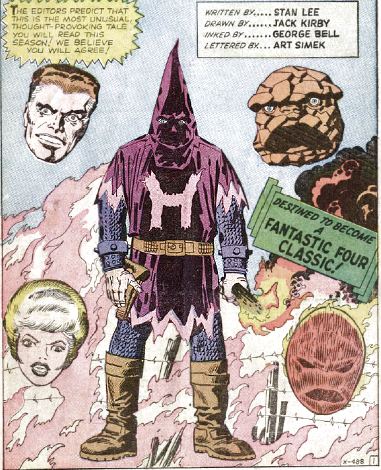
But look deeper. This is not a silly issue. It's the most serious one ever published.
The letter H
The H is almost certainly a stand-in for a cross. The Hate Monger is a Hitler clone, and wears a knight's costume plus
Ku Klux Klan style hood. This was in 1963, at the height of civil rights
movement, where the KKK was still am force to be reckoned with. The KKK
saw themselves as knights, encouraged by the movie Birth of a Nation.
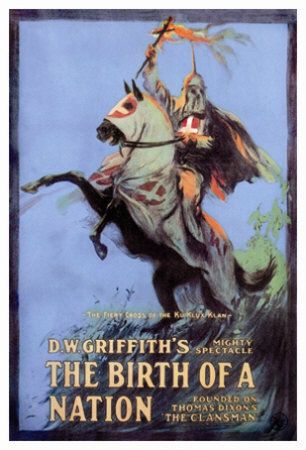
The KKK and Nazis both saw themselves as Christian knights.The KKK call themselves knights and burn crosses. Nazis associated
themselves with the Teutonic Knights: the famous "Iron Cross" medal was
based on a Crusader
cross.
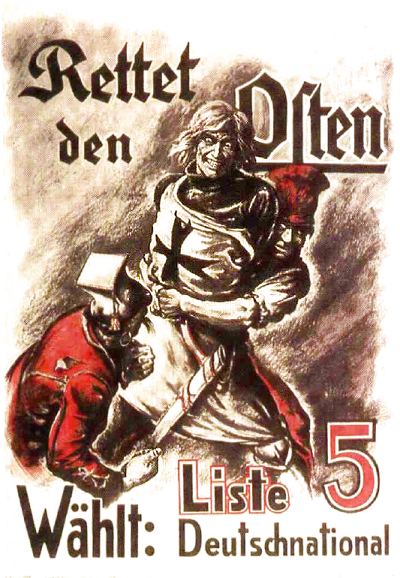
Above: a genuine Nazi propaganda poster, showing Nazis as holy victims of evil Poles and socialists.
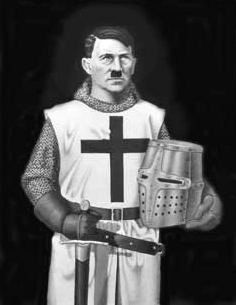
Above: a modern poster showing Hitler as a Teutonic Knight.
Notice what is on the tabard: not a letter H, but a cross, symbol of
Christianity. What were Lee and Kirby, both Jews, supposed to do? Show the hate monger
as a Christian? This was 1963: no matter how controversial that would be
now, it was more sensitive back then. The purpose of the story was not
to annoy Christians, but to condemn hate, so he drew the costume as a
letter H. Because that is what the cross in that context meant.
The name "Hate Monger"
As for the name "hate monger" that is obviously a name given by the
media. Note that it is first used in a scene full of newspapers. Hate
groups usually give themselves good sounding names. For example, The Southern Poverty Law Center
keeps track of what it calls "hate groups" and many of them have names
like "American Family association" and "family research institute". The
real hate monger would say "I am trying to save families" and would
always make himself sound good. The comic just cuts through the
propaganda and translates what he really means.
A brave, challenging comic
"The FF just HAPPEN to go up
against a villain that looks a LITTLE bit like the local Grand
Dragon. The Hate-Monger himself is revealed to be none other than
public enemy #1 Adolf Hitler himself. Remember, this is ’63, not
even 20 years since the end of WWII. And what better way to show
how un-American the anti-civil rights movement of the KKK was than to
(in this fictional four-color world) make it’s leader the face of evil
around the world. Symbolically, this was truly brave writing for
what was ostensibly
a child’s publication. You can imagine how hard is was for 8 year
old Billy-bob to be all right with Pappy’s nightly bed-sheet bedecked
racist rides after watching the ever-loving blue eyed Thing stomp a mud
hole in Pappy’s comic-book counterpart." (source)
A nuanced message
This issue is not a one dimensional polemic against hate: it contains
layers of nuance. For example, we learn that America is spending
billions in Central America, yet the Central Americans see America as
the enemy: this is something Americans were slowly becoming aware of via
the news (thought it would not become mainstream for a few years). Of
course the invading Americans say they are only doing good: but every
invader says that, and often believe it.
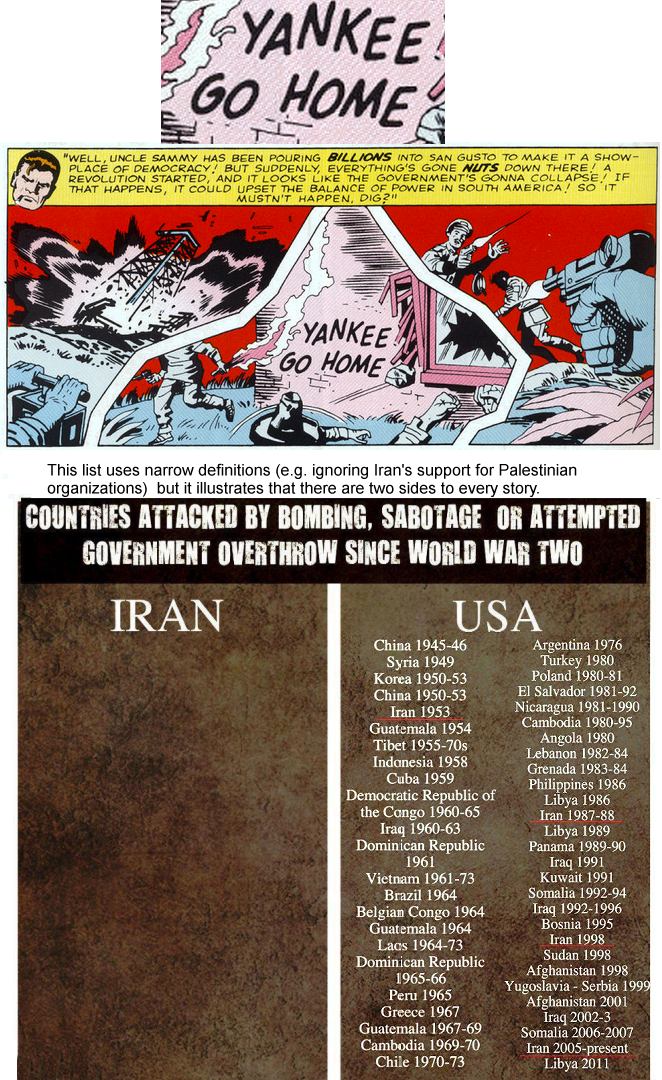
There no good guys in this story. Reed is motivated by hate. Only
Nick Fury appears innocent, but what of his masters, the CIA? A couple
of years after this, Nick stopped working for the CIA and chose an
international organization instead. Why?
Criticisms
- Hitler survived?
This issue has been criticized (in the FFPlaza review) for using
Hitler, as it may imply the real Hitler was immortal. But Reed at
the time said it could have been a double: he and Nick Fury both
agreed that the exact identity did not matter. It is only modern
readers who see Hitler the man as important. The message of this
story, stated explicitly in the final panel, is that another
Hitler can easily arise if we let ourselves hate those who are
different. Stan Lee and Jack Kirby were Jews who fought in
WWII, and lived to see the truth come out and to see many Nazis
escape to South America, the scene for this story. I trust their
judgment on this matter above any modern commentator.
- Avoiding the hate ray?
The hate ray is no doubt a variation on the ray used in FF7 and found by
the Puppet Master: see the notes by FF 8. The Hate Monger does not want
to use it on himself. Why not? Because any hate ray would work by
messing with the normal functioning of the brain, making people's
reasoning skills weaker. There is no need for the hate monger to weaken
himself in this way as he already hated through natural causes..
- The CIA
One reviewer mocked the CIA here for claiming to be whiter than white.
But organizations (including government organizations) always claim
innocent motives, and usually believe it.
- Monologing
Why does the Hate monger tell his rivals his plans instead of just
killing them? This is probably a commentary on hate preachers and their
need to be validated. People have to hear his reasons, so he can believe
he is on the side of right. He would also be talking for the benefit of
those around him. The hate ray tends to make people disloyal (as we saw
at the end) so he needed to constantly emphasize his own brilliance.
Note that he did not tell Richards why he was doing it, he merely wanted to demonstrate his ability.
- Is infighting normal anyway?
What is the point in making the team fight if they normally fight
anyway? No, they don't: and that is the point. They did until Reed's
triumph in issue 13-14, and after that they accepted defeat but bottled
up their frustration 0see the notes to FF16: they would not admit
shrinking, as it might be turned against them as a sign of weakness).
Reed has won, but the tension is still below the surface, which is why
the hate monger can use it against them. Mind control typically just
amplifies what is already there. Direct control of words and movements
is far too much work.
Technology
- Anti-gravity
How did the hate ray affect the moon's gravitational pull? As noted
earlier, it almost certainly uses alien technology, probably derived
from the robot from planet X (FF7: and see notes to FF8 and FF144).
Planet X was noted for its anti gravity.
Other points to note
- This issue is a good example of how a single gigantic story is
unfolding in real time: this issue features the only
(contemporary) appearance of Nick Fury, wartime friend of Reed
and Ben, before his new role as 1960s spy master. Although his war
tales were published in the 1960s they were in the tradition of
many such tales that Kirby drew in earlier years. By growing
older, retiring from the army and becoming a colonel in the secret
service, Nick demonstrates that real time and real
change can lead to stronger, deeper characters.
- Sue tries on an Elizabeth Taylor wig: this coincides with the
release in 1963 of perhaps Taylor's most famous role, Cleopatra. And
recall that Sue was spotted by a movie talent scout in FF15.
22
Issue 22: two races
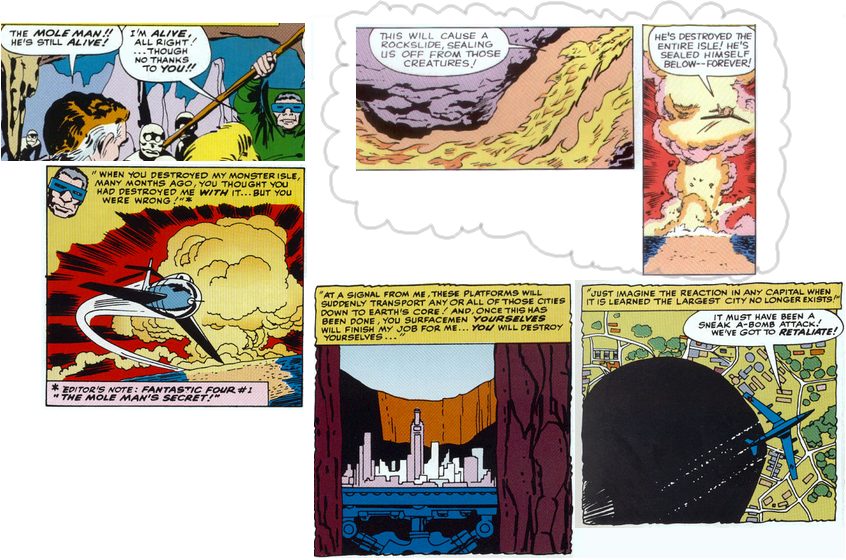
FF21 was about race hate. In FF22 we see a new race as an example:
can we apply our abstract values in a real situation? Here we have an
excellent example of one group believing they are the good guys while
actually causing the problems, and treating another race as inferior.
The trouble is, the people doing the harm and looking down on others...
are us. The Fantastic Four does not shy away from hard questions, even
though readers usually don't notice.
In FF22 we see the Mole Man's race of Moloids for the first
time. We see a whole race who are treated as the enemy when
they are not. Note the parallel with H. H. Wells' Time Machine:
the underground people are generally agreed to be a metaphor for the
invisible lower classes of our own day (in Wells' book they were the descendants of today's workers).
The Mole Man in context
For how the Mole Man's ten appearances reflect racism and the underground in America, see the notes to issue 1.

Confronting racism forced America to question its origin myth, and
for the Fantastic Four this means going back to the Mole Man. And
finding that when they thought Moley had blow up his own island,
it was probably Reed's team who did it. here are shades of
Vietnam: they meant well, but only won the immediate battle: they
may have made things worse. Note that the story, like the last
one, hinges on man's hatred for his fellow man. Moley does not
need to attack, we will attack each other. In Act 5 Ben will
finally end the Mole Man's threat... by understanding his point of
view.
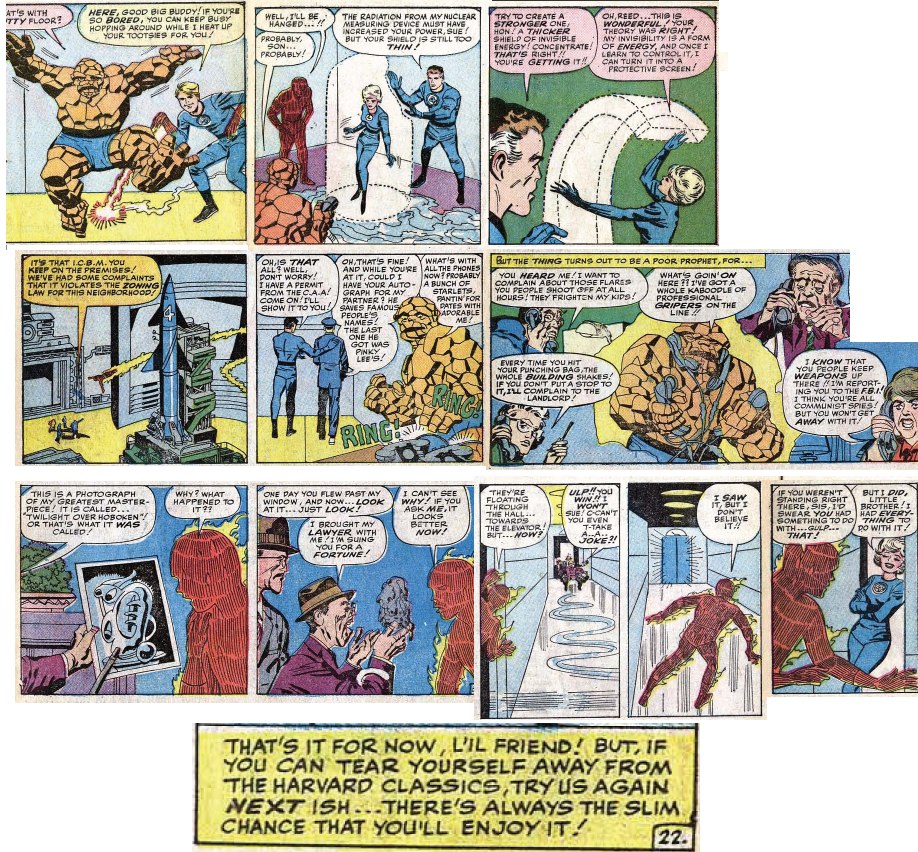
Appropriately...
This issue, about racism, also strikes a blow for sexism. The FF's
powers were fundamentally sexist: the three men were effectively
bulletproof, and the one woman was not, yet she was expected to face all
the same dangers (without having any say). The bulletproof problem is
corrected in this issue, as Sue gets a force field, to match Reed's
rubbery skin, Johnny's flame barrier and Ben's hide.
The death of Kennedy has permanently changed the nature of
the team. The Fantastic Four is a metaphor for America, so it
could not be any other way.
Firsts!
This is a story full of firsts:
- First Forcefields
This is the first issue where we see Sue's forcefield. This
is often taken as Sue becoming more powerful, but as noted in
Act 1 and elsewhere, she was
already the most powerful member if we measure power by long
term outcomes. The nature of superpowers, and how one power
can led to another, is
discussed here.
- First "Clobberin' time"
This is the first issue where we hear "It's Clobberin' Time"
- usually seen as a joyful thing, but it has a sad underside:
it represents Ben making the best of his diminished role:
the serious test pilot accepts a role as the dumb muscle of
the group.
- First "Aunt Petunia"
FF25 contains the first reference to Ben's Aunt Petunia, who appears in FF238-FF239.
- First Moloids
And of course, the first mention of the dominant race within our planet!
- And probably more that I didn't notice. Expect this list to updated next time I read this issue.
Other points to note
-
The Great American Novel
Note the playful acknowledgment at the end that these stories
are worth putting down "the classics" for.
- FF1 redux?
This plot is sometimes criticized as a replay of FF1,
but its purpose is to make us re-examine the FF's actions: at
no point has the Mole Man actually harmed anybody, he just
provokes the surface people to show their true colors. As with
all great literary characters he makes us see ourselves in a
different way. Click
here for more about the Mole Man as innocent victim.
- Leadership?
Note how Reed orders the team around, enforcing his role as leader,
especially on two occasions: escaping the pit and later escaping in the
vehicle. In both cases,if Reed had not undermined Ben then Ben could
have solved both problems more quickly:
- First, Ben could jump out, taking the others with him. Ben's
dislike of jumping is tied to his fear of hurting others: rather than
learning how to do it safely, his Reed-induced lack of confidence holds
him back (see Ben's own page for details).
- Ben can solve the Mole Man's problems
by becoming his friend, as finally happened in annual 13 and FF296. But
every time he wants to, Reed and Johnny make the situation worse by
looking for conflict as the only solution.
23
Issue 23: Reed consolidates his power
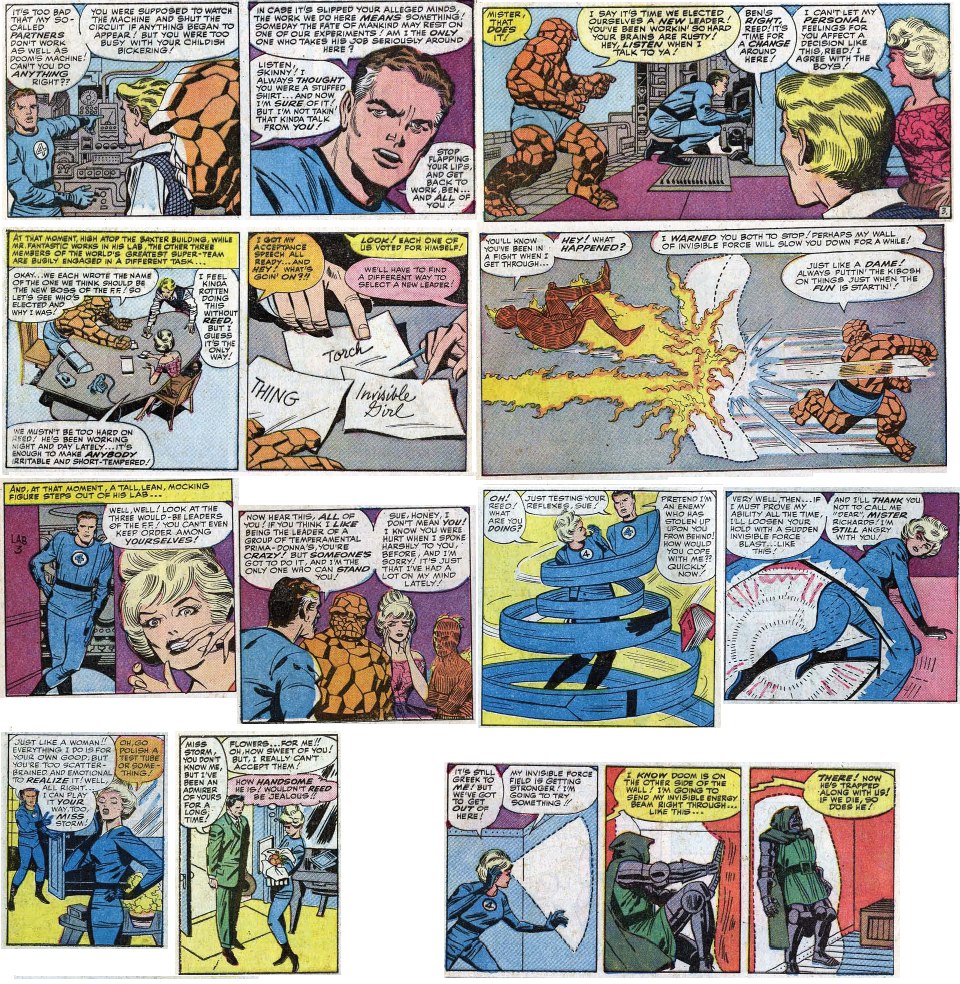
With Sue now more conventionally powerful, Reed needs to
maintain his position. Any Alpha male must prove himself. Note that the election is
controlled by a master strategist. Obviously they would choose
themselves, and then criticize each other, but they are adults:
this would not have lasted long. They would quickly move to the
normal method: only allow a vote for someone else, or even choose
a different voting method (weighted preferences, take turns to
lead, etc.). But before they could come to an adult decision Reed
stepped in straight way and declared them unable to govern
themselves. This is the classic tyrant's method, arrange an
election according to your rules, so that the result will be
indecisive, meanwhile fan the conflict between the parties, then
step in and say that this proves only you have the maturity to
lead. Note that Reed takes the opportunity to mock and belittle
the others. Only an insecure person makes himself feel good by
pushing others down.
Reed's strength and weakness
This issue contrasts Reed's political strength with his emotional and leadership weaknesses in several ways:
- Doom for contrast:
Since the story is about Reed's need for complete control,
who better to draw attention to this than his more extreme
mirror, Victor Von Doom?
- Weakening the others:
Reed's need for control has weakened the team. His sexism
alienates Sue, who is then vulnerable to Handsome Harry. And
Sue is the one who eventually saves them.
- Reed's attitude:
Most people do not notice Reed's darker side in other issues,
but in this issue it's obvious. As Greg Allinson writes in his
FFPlaza review:
"WHAT THE HELL WAS REED'S DEAL?! The
story tries to explain that he was under pressure because he was
worried about Doom, but he was calmer and more composed when
Galactus first set foot on Earth, for pity's sake. I was
half-expecting a revelation that he was being manipulated by Doom,
but no -- he really was that big of a jerk in this story.
Furthermore, he never really apologizes for his actions to Ben or
Johnny. Pressure or not, Reed was wildly out of character in this
story. It's hard to get behind your lead hero when he's acting
like a self-righteous paranoid."
But far from being out of character, this
attitude has been visible in every issue. it is at its worst here
because for the first time his power was directly threatened. But
this is not to say Reed is a villain: Reed is a genuine hero, one
of the greatest, but he's three dimensional, and his need to
control is his Achilles heel.
- The Pink Panther
In the previous issue Sue received a major power increase. This issue
Reed tries to assert his superiority, but in such an immature way it
just makes him look foolish: he attacks Sue unexpectedly. He thinks this
a good way to always be prepared! This predates the Pink Panther movies
by a few months: although the first Panther movie came out in 1963,
Cato did not appear until the second movie in 1964. Like Reed, the
bumbling Inspector Cluseau thinks the best way to be prepared is for his
servant Cato to attack him at unexpected times. The FF is ahead of the
curve.
The Thing robot
At first glance, in FF23 Doom appeared to destroy his Thing robot,
before dispatching his men to another dimension. Then in FF39 Reed had
an almost identical robot.
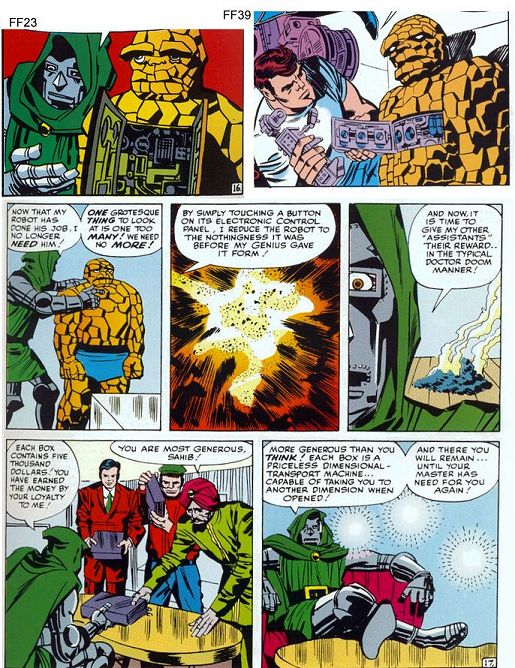
But did Doom actually destroy the robot? He never said the robot was
destroyed, simply that it returned to the nothingness "from whence it
came". The key is the manner of destruction. It self destructed without
any damage to its surroundings, and left a pile of ashes that appears to
be much less than the mass of the robot. Since mass cannot be
destroyed, and insufficient energy was released, we must conclude that
it, like the three servants, and like Doom himself, was returned to
another dimension. The pile of smoking dust suggests the results of a
demonic dimension. For more about Doom's robots and his use of demonic
magic, see the notes to FF143. The robot and the three men went to
different dimensions: there was no fire and brimstone for the men
because there was no demonic possession. Doom needed a demonic dimension
for the Thing robot, but the men had their own life so could be sent to
a safe place.
This robot appears to be the same one used by Reed in FF39, so how did
Reed get it back? The end of FF34 (where Gideon somehow obtains Doom's
time machine or something like it) may give the answer. Gideon sends Ben
to another time. It is intended as a one way trip, but when the
machine's power is shut off he automatically returns. Presumably they
would have remained even after the power was shut off if left there long
enough, but the speed of events was important. The Thing Robot was
valuable to Doom, so he would have retained some kind of connection so
he could bring it back and use it again as needed. At the end of FF23
Doom is thrown through a dimensional portal. As with shutting down power
to the time machine, removing Doom would have led to the Thing robot
popping back into this reality. Presumably the demonic control was then
lost, so Reed had to devise a device to let Ben control it directly.
Kirby's original story
Note: the following assumes familiarity with the page on "who did what",
where I show the evidence that Kirby plotted the books after the
briefest of instructions from Stan Lee, and Kirby was an avid book
reader.
For many years I have wondered, why is this such a badly written
story? It claims to be "the master plan of Doctor Doom", yet is all over
the place. It begins with a dinosaur and a time machine, and Reed
treating the others like children. Then the main part is the three
enhanced villains. Then right out of nowhere we have this "solar wave"
thing. And something about that ending just seems awkward, badly paced.
It's not a great issue. But look at it again, without Stan Lee's dialog.
The art tells a different story where everything fits together. But
Stan Lee
"improved" it to make it easier for new readers to understand. Here is my evidence:
- Pacing:
Page 22 (where the "solar wave" is explained) breaks the pacing. Kirby
is generally cinematic in his art: each frame flows into the next. This
is especially true of an action climax. Here we have the final battle,
and suddenly everything stops to give us diagrams of how a solar wave
works. It is very un-Kirby. Worse, this weakens the emotional power of
the climax. The story is about Reed and Doom treating others as serfs,
and both discovering that this does not work. Reed is trapped in a
soundproof box and needs rescuing, and Doom (at the end) is forced to
share the fate of the others: if the serfs go
down then the king goes down too. The last two pages flows smoothly and
easily, showing the conflict with Doom. but it is interrupted by the
solar wave material, distracting from and weakening the main message.
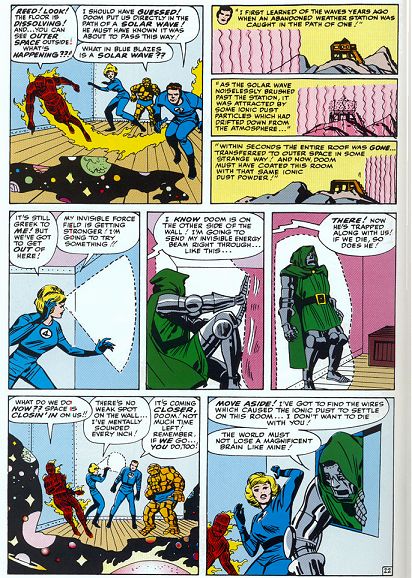
- Squashed art:
The solar wave explanation is three frames squashed into the space of
one. This issue uses relatively large panels throughout, usually six or
seven panels on a page. But this page (and only this page) has nine. It
looks like one normal sized panel has been removed to squash in three
panels of cramped explanation.
- Not Kirby?
The cramped new panels do not look like Kirby art. Though that could be
because the pictures are so tiny. It looks like somebody scribbled an
idea on the back of an envelope and the inker had trouble turning it
into something that fits the comic.
- Redundant:
The "solar wave" explanation is not needed. The story established that
Doom could transport people by having them touch something, using either
occult power or something like his time machine. Or even his Ovoid
teleporter. So the solar wave is redundant.
- Breaking the unity of the story:
Without the solar wave, the story forms a unified whole: Kirby
introduces the story with the time machine to remind us that Doom is
obsessed with dimensional travel. All of Doom's stories to this point
have been about dimensional travel (if we count consecutive issues as
being one story in to parts). The first Doom story was about time
travel. The second one was about mind transference. The third was about
shrinking into another dimension. The main part of this story ends with
Doom sending his three henchmen to another dimension. It follows that a
natural ending would be Doom doing the same thing to the Fantastic Four,
only this time dumping them far away in outer space to die!
Therefore this book is perfectly titled "the master plan of doctor doom"
because his whole career led to this point. But the solar wave thing
ruins that. It just comes out of nowhere: rather than this being the
fruition of his all encompassing plan (the meaning of he phrase "master
plan" after all) it becomes some random thing Doom discovered and then
decides to use against the team. It ruins a great story.
- Not like Kirby science
Kirby's science is all based on either the real world, or reflects well
established story tropes from literature: for example, dimensional
portals are not new, and are explained either as naturally occurring
worm holes or as the result of complex advanced technology. But the
solar wave claims to be a natural phenomena that routinely sweeps ionic
dust, and anything attached to it, into another dimension. There is
nothing in nature like this, nor is there a mechanism to explain how it
might occur, nor does it appeal to high technology or even magic. As an
idea it just does not fit anywhere. Similarly, how can one particular
warehouse be in its path of this wave whereas other buildings are not?
Waves from the sun tend to bathe the whole planet, and even something
relatively small like an eclipse has an enormous and soft-edged
footprint. How is the wave so narrow and precise? None of this sounds
like anything Kirby would devise.
- Stan's fingerprints
The has Stan Lee's fingerprints all over it. Stan likes to explain everything. When a Stan lee character does something he says
he is doing it. So when Kirby handed in two pages where a room is
gradually disappearing into outer space, you can bet that Stan would say
"we need to explain what is happening". Of course it should be obvious:
Kirby has already shown us two similar events in the same story. But
Stan would want it explained in detail for the benefit of new or younger
readers who are maybe not paying close attention.
- Stan often did this
The breaking of continuity for an unnecessary explanation reminds me of
FF 3 where Stan did the same thing: the pencils show that he changed a
smoothly flowing Kirby page into something that jumps around in order to
give an information dump. The same thing almost certainly happened with
the Mole Man story i issue 1: it has signs of heavy re-editing all over
it. The best known example of this is FF 108, which was completely
chopped into pieces and rearranged with new art and a lot of
explanation. Another example is FF 124, where an old picture of the
Thing is pasted over the art to cover what looks like some rearranged
pages. There are no doubt other examples.
- Real science, but misunderstood
The reference to solar waves interacting with ionic particles suggests
that Stan is referring to real science but he does not understand
it. Everything about the "solar waves" sounds like the solar wind:
- The names solar wave and solar wind are similar.
- The solar wind is made of ionic particles (i..e charged
particles). However, in Stan's version ionic particles somehow just
drift down from the sky, and the wave interacts with them. He seems to have missed the crucial part that the solar wind is made of those particles.
- The wind comes in waves, depending on the activity of sunspots
and the position of the earth. but Stan seems to imagine waves nor much
wider than a warehouse, rather than the actual planet sized waves.
- The solar wind strips particles out of a planet's atmosphere and
hurls them into space. (Earth is largely protected by its magnetic
field, which is why we have a good atmosphere and Mars does not).
- The solar wind was big news for science geeks in late 1962: its
existence, proven by the Russians in 1959, was now explored in detail by
America's Mariner probe that was heading for Venus. So in mid 1963,
when Stan was looking for an idea to explain the art that showed people
thrown into space, the new and still mysterious "solar wind" would come
to mind
- He got the idea from somebody else
Jack Kirby was an avid reader of science magazines (see his collages for
example), and his comics are full of new ideas. But Stan's solo work
(e.g. the FF after Kirby left) has few if any new ideas. So when Stan
wanted an science explanation for the space and stars seen on page 22,
it as probably Kirby (or somebody else in the office at the time) who
suggested it.
Maybe I am wrong. Maybe Kirby just decided to sabotage his own work
and act completely out of character on that one page. But I'm betting it
was Stan Lee.
Other points to note:
- Why did the time machine turn itself on?
Later issues show that this is a copy, not Dr Doom's original. Clearly Reed hasn't got it right yet.
- Why this issue matters for Doom
For where this issue fits into Doom's twenty appearances see his own page.

24
Issue 24: foreshadowing the bigger story
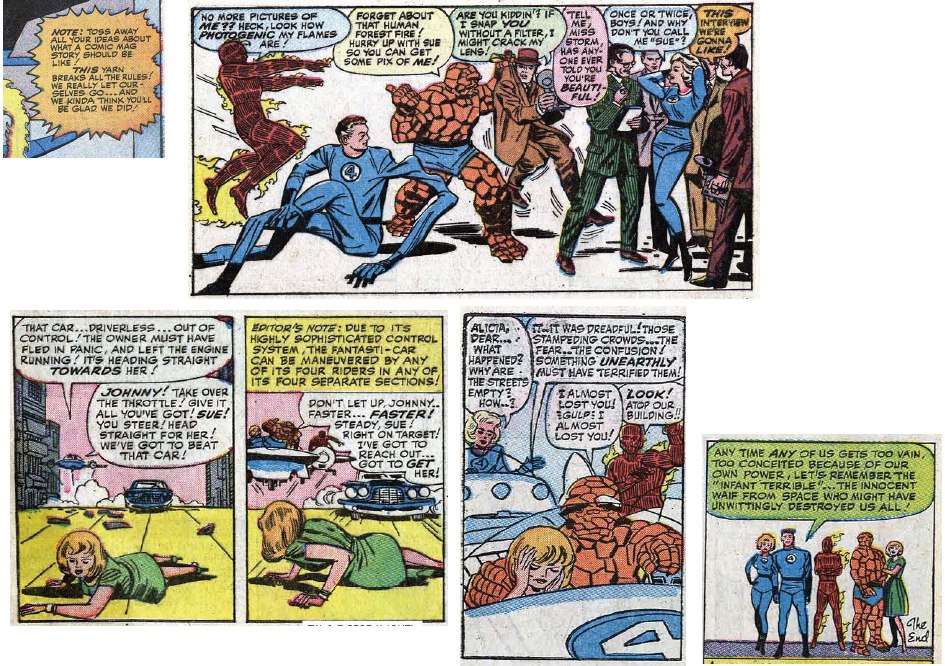
Now Reed has the team where he unconsciously wants them: Sue and
Johnny act like children, and Sue is his trophy partner, no longer
in any danger of being so independent as to choose Namor. With
this new status quo (for the next few issues at least), the story
can look to the longer term future. Of course, these long term
plots threads are not a conscious master plan by Stan and Jack,
but they arise naturally from the characters themselves. E.g.
there are only so many basic stories involving families. These
stories are so powerful precisely because they deal with vast
timeless themes.
The Infant Terrible foreshadows Franklin: a child who without
realizing what he is doing, has apparently infinite power (note
"apparently" but for now we will assume it is so), and who
controls things simply to feel safe or because he likes an idea,
without understanding its consequences (such as slowing own time).
The solution to the problem is not to fight, but to recognize that
the source of the power is a child, and then for his parents to do
their job. This is how Reed and Sue finally solve their problems
in Act 5.
Ben's neglect of Alicia, while continuing the subplot of Ben's
pain that dominates the first half of Act 2, foreshadows Ben's
ultimate solution. He cannot continue to leave her: he has to be
with her and he knows it. But while he has a child-like role in
the team he lacks the confidence to marry her. She deserves more
than to constantly be lonely and in mortal danger. Ben knows that,
but through his depression he can't see a way out. Ironically it's
young Johny Storm who will finally show older, more mature Ben the
way: marry the girl and bring her with you!
Be nice to outsiders
This is one of a number of stories illustrating the theme, "be nice to outsiders":
- The Infant terrible did not mean any harm, and fighting him would have ended in disaster
- The Impossible Man was the same
- And the Silver Surfer, etc.
America is a nation of immigrants, and Stan Lee and Jack Kirby (Jews
in New York who experienced World War II) would be more aware of this
than most.
The zeitgeist
The 1960s zeitgeist is strong here:
- The story tries wild new ideas! A villain who's not a villain
but just a lost kid? This predates the Star Trek episode "The
Squire of Gothos" by several years.
- Sue is keeping up to date with fashion: this is 1964, and the
big movie is Elizabeth Taylor's Cleopatra, with lots of makeup
(especially; around the eyes). Personally I'm glad that she
didn't keep the heavy makeup look, and hope she didn't just do
it for Reed, her Richard Burton.
- Gregg Allinson observed, "The alien ship is clearly modeled
after the Martian ships from George Pal's 1953 production of War
of the Worlds -- so much so that when Reed is looking at it
through his telescope, it looks like Kirby merely used some
stills from the film to represent the ship. It even shoots out a
burst of flame after Reed catches a glimpse of it (the Martian
ships used flamethrower-style weapons in the film; perhaps the
creature's parents were trying to signal Reed?"
- The book becomes more self-effacing with this issue: it begins
Marvel's famous crazy credits: "Lovingly written by Stan Lee;
Tenderly drawn by Jack Kirby; Heroically inked by Geo. Bell;
Neatly lettered by: S. Rosen" - previous issues were simply
signed at the edge of the page. Stan and Jack are co. are
creating the Great American Novel here, and are becoming
stars in their own right.
- The alien craft, first seen in a photo montage, are from the 1953
movie version of War of the Worlds. This reflects the optimism of the
FF: as in H G Wells novel, the aliens are highly advanced, and have
tentacles that emit rays. But the FF aliens are not malicious, and they
do not have to die.
Other points to note
- Sue could have solved the problem
Sue's expertise is with children. She was about to gently get closer to
the infant when it was scared by the photographers. When she is next
close the child is scared away by the violence of men in general, but on
her own she could have just been his friend: he responded very well to
friendship. As for Reed's fear that the child would reach out and
attract the sun, this reflects Reed's narrow view. yes, it is possible,
but think of his background and culture: wherever he is from they are
likely to have their own sun, so would learn from a very young age not
to do that, even if it had the power (which is doubtful). Of course, Sue
did not know he was a child at that point, but if she had been on her
own she would have had more time to calmly observe. so would have soon
figured it out.
- Secret Wars II
The always excellent Wait, What podcast
pointed out that the plot of this issue was repeated years later for
Secret Wars II: unimaginably powerful being arrives on earth but is
naive and is befriended by crooks
- Splash page
The splash page to FF24 is used in the 1990s painted "Marvels"
series. Alex Ross chose the Gilligan's Island professor as the model
for Reed Richards.
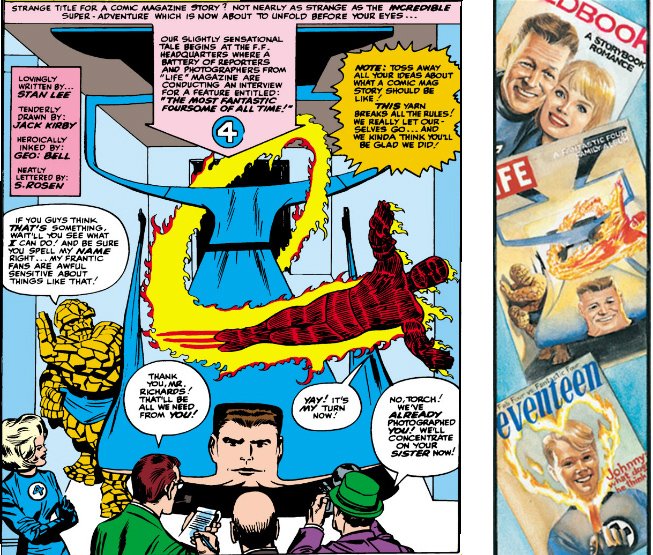
This illustrates how Reed was retconned after the Marvel Universe
ended. For more about he changes click
here. For more about the original Reed, click here. The original Reed was
based partly on the professor
trope as in Gilligan's island, but equally was based on Doc Savage
and on Hamlet (hence the
reference in FF22 to being worth putting down the Harvard Classics
for). By reducing Reed to merely a professor we lose two thirds of
his personality and all the depth. (This composite image is
shamelessly swiped from the very helpful "ff1by1" site. Thanks, ff1by1!)
Alex Ross is a great artist, but I'm not a
fan of his Gillgan's Island Reed. I much prefer Paolo Rivera's take on
this era: I think he captures the characters perfectly. So I will end
with this perfect image. The faces are perfect. The poses are perfect,
everything is perfect. I cannot praise this image enough: it captures act 2 to perfection, just as Rivera's more famous
beach scene (from FF 97) captures
act 3. I suppose it's because Rivera tries to capture an era in
American history, and that's what the Fantastic Four is all about.
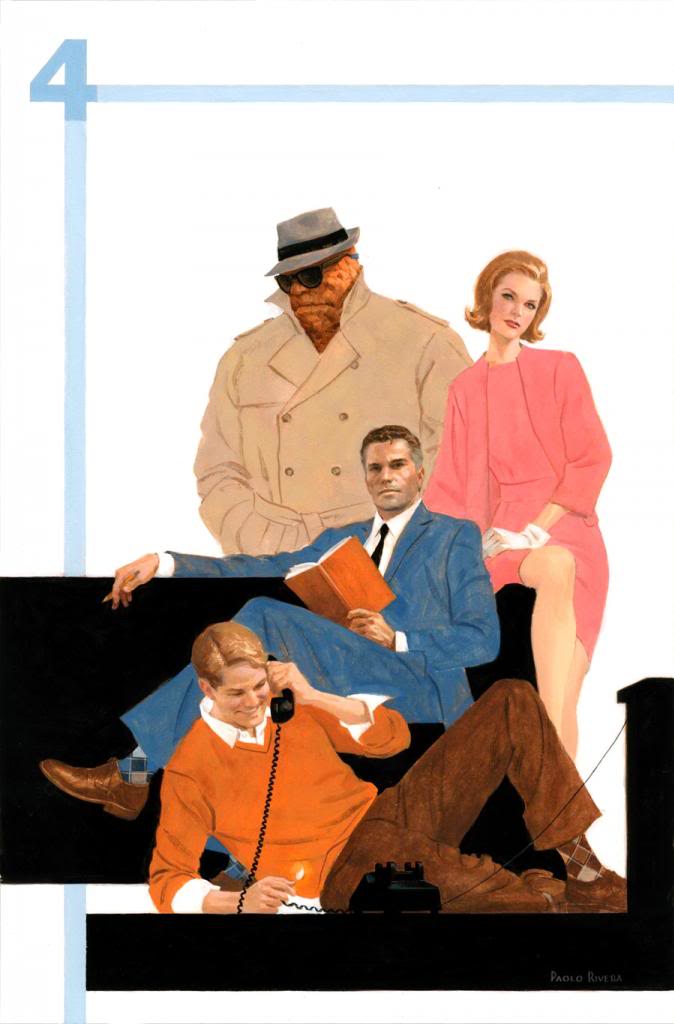
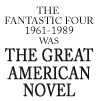


















 15
16
17
18
19
20
21
22
23
24
15
16
17
18
19
20
21
22
23
24















































